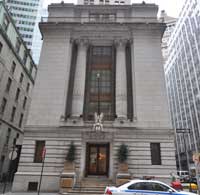
About UsThe Numismatic Bibliomania Society is a non-profit organization devoted to the study and enjoyment of numismatic literature. For more information please see our web site at coinbooks.org SubscriptionsThose wishing to become new E-Sylum subscribers (or wishing to Unsubscribe) can go to the following web page link MembershipThere is a membership application available on the web site Membership Application To join, print the application and return it with your check to the address printed on the application. Membership is only $20 to addresses in the U.S., $25 for First Class mail, and $30 elsewhere. For those without web access, write to: Terry White, Treasurer
AsylumFor Asylum mailing address changes and other membership questions, contact Terry at this email address: terrywhite5475@yahoo.com SubmissionsTo submit items for publication in The E-Sylum, just Reply to this message, or write to the Editor at this address: whomren@gmail.com BUY THE BOOK BEFORE THE COINSale Calendar |
- WAYNE'S WORDS: THE E-SYLUM MARCH 20, 2016
- LAKE BOOKS SALE #124 PRICES REALIZED AVAILABLE
- SELECTIONS FROM BALDWIN'S NUMISMATIC LITERATURE OFFERINGS
- NEW BOOK: AMERICAN SILVER EAGLES, THIRD EDITION
- EL SITIO NO. 18 PUBLISHED
- BOOK REVIEW: COMPREHENSIVE CATALOG OF CONFEDERATE BONDS, 2ND ED.
- WAYNE WILCOX (1936-2016)
- NEWMAN PORTAL INCLUDES THE COLONIAL NEWSLETTER
- STEVE ROACH ON ONLINE NUMISMATIC RESOURCES
- MORE ON FRANK J. KATEN
- HARRY SHEPHERD VAN DENBERG (1885-1963)
- NOTES FROM E-SYLUM READERS: MARCH 20, 2016
- HIKER FINDS RARE 2,000 YEAR OLD GOLD COIN
- COINS OF THE TWELVE CAESARS
- 1646 DUTCH COLONIAL BRAZIL SIEGE COIN
- 1794 BATTLE OF THE GLORIOUS FIRST OF JUNE MEDAL
- JACOB PERKINS AND NEWBURYPORT COINAGE LECTURE
- U.S. MINT REGAINS DISPUTED 1974-D ALUMINUM CENT
- HOW DENNIS TUCKER GOT STARTED IN NUMISMATICS
- UNDER-RESEARCHED AREAS OF NUMISMATICS
- MORE ON MILTON BRADLEY’S EDUCATIONAL TOY MONEY
- SELECTIONS FROM HERITAGE NEWMAN INTERNET PART 1 SALE
- BBC NEWS REPORTS ON VALUE OF 1794 DOLLAR
- 1850 DOUBLE EAGLE ILLUSTRATED
- MARCH 2016 NUMMIS NOVA PHOTOS
- WAYNE'S NUMISMATIC DIARY: MARCH 20, 2016
- CITIZENS COINAGE ADVISORY COMMITTEE SEEKS TWO MEMBERS
- ARCHIVES INTERNATIONAL SALE XXXII APRIL 11-13, 2016
- AMERICAN BANK NOTE BUILDING FOR SALE
- WILL ALEXANDER HAMILTON STAY ON THE $10 BILL AFTER ALL?
- THE SMITHSONIAN'S WOMEN ON MONEY EXHIBIT
- HOW THE WORLD'S CURRENCIES GOT THEIR NAMES
- OTTOMAN BANKNOTE EXHIBIT IN ISTANBUL
- INDIAN OCEAN SHIPWRECK YIELDS RARE INDIO COIN
- ANCIENT EGYPT'S MOST LITERATE TRASH HEAP
- COIN COLLECTING CONUNDRUMS
- GARY BEALS: NUMISMATIC VOCABULARY RUN AMOK
- FEATURED WEB PAGE: BRAZIL 960 REIS SILVER
Click here to access the complete archive
To comment or submit articles, reply to whomren@gmail.com
WAYNE'S WORDS: THE E-SYLUM MARCH 20, 2016
New subscribers this week include: Stephen C. Cawood. Welcome aboard! We now have 1,957 subscribers.
You know you're getting old when the classic rock station starts playing tunes you've never heard before. Or maybe it's when your internet ads switch from "Meet hot singles in your area" to "Click here to learn more about blood pressure medication".
This week we open with an update from literature dealer Fred Lake, fixed price offerings from Baldwins, one new book, a new periodical issue and one book review.
Other topics this week include The Colonial Newsletter, the Twelve Caesars, the Glorious First of June medal, Jacob Perkins, under-researched areas of numismatics, toy money, colonial-era scrip notes, and the 1850 double eagle.
To learn more about the Pridmore sales, Parque Munich tokens, Banca Oriental coins, the Geoctroyeede West-Indische Compagnie, Francis
Spinner correspondence, women on money and coin collecting conundrums, read on. Have a great week, everyone! Wayne Homren
Editor, The E-Sylum
LAKE BOOKS SALE #124 PRICES REALIZED AVAILABLE
The prices realized list for our mail-bid sale #124 of numismatic literature is now posted on our web site at http://www.lakebooks.com/current.html. Reference material In many of the diverse areas of coinage, paper money, tokens and medals and Exonumia was eagerly sought by keen-eyed bidders. Our next sale will be held in the early Fall with more excellent books and catalogs consigned by prominent collectors. Good Luck with your bidding, Fred
Lake Books
6822 22nd Ave N
St. Petersburg, FL 33710-3918
727-343-8055 fax: 727-381-6822
SELECTIONS FROM BALDWIN'S NUMISMATIC LITERATURE OFFERINGS
Catalogues Des Monnaies Russes
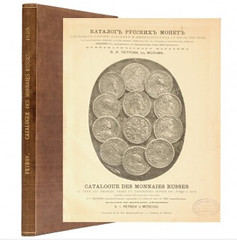 Petrov, V. I. Catalogues des Monnaies Russes de Tous les Princes, Tsars et Empereurs depuis 980 Jusqu’a 1899. Second edition.
Moscow, 1899. Quatro, pp. (2), 86; 46 line drawn plates. Text in French and Russian. Neatly bound in full brown cloth, gilt.
Petrov, V. I. Catalogues des Monnaies Russes de Tous les Princes, Tsars et Empereurs depuis 980 Jusqu’a 1899. Second edition.
Moscow, 1899. Quatro, pp. (2), 86; 46 line drawn plates. Text in French and Russian. Neatly bound in full brown cloth, gilt.
For more information, or to order, see:
www.baldwin.co.uk/catalogues-des-monnaies-russes.html
The Complete Pridmore Sales
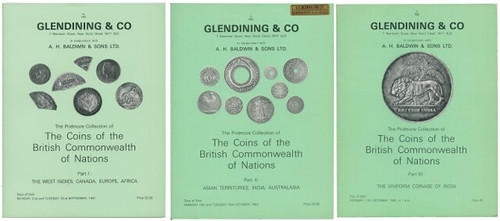
[Glendining & Co.] The Pridmore Collection of the Coins of the British Commonwealth of Nations. Complete in three parts. London, 1981-1983.
Part I. The West Indies, Canada, Europe, Africa. 21st & 22nd September, 1981. 89pp, 776 lots; 32 plates.
Part II. Asian Territories, India, Australasia. 18th & 18th October, 1982. 102pp, 822 lots; 25 plates.
Part III. The Uniform Coinage of India. 17th October, 1983. 51pp, 315 lots; 9 plates. List of estimates loosely inserted into each part.
All three parts in the original card covers, little if at all used. An important record of a major collection.
For more information, or to order, see:
www.baldwin.co.uk/the-complete-pridmore-sales.html
Pridmore On The European Territories
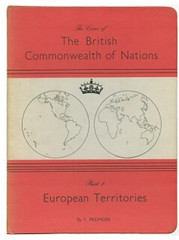 Pridmore, F. The Coins of the British Commonwealth of Nations. Part 1. European Territories. London, 1960. Quarto, pp. 98, photographic
illustrations throughout.
Pridmore, F. The Coins of the British Commonwealth of Nations. Part 1. European Territories. London, 1960. Quarto, pp. 98, photographic
illustrations throughout.
Original printed boards, spine a trifle faded. Minimal wear. Out of print and highly sought after.
For more information, or to order, see:
www.baldwin.co.uk/pridmore-on-the-european-territories.html
To read the complete Baldwin's book list, see:
www.baldwin.co.uk/catalog/category/view/id/321
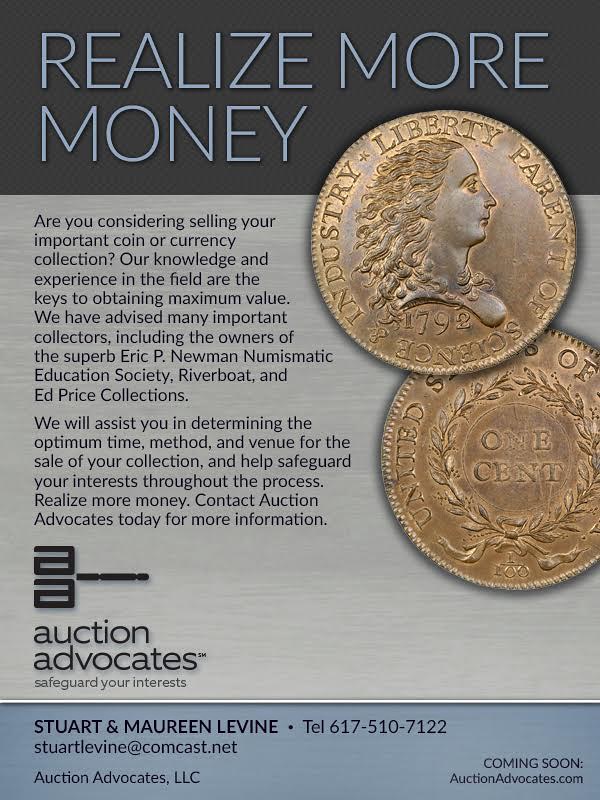
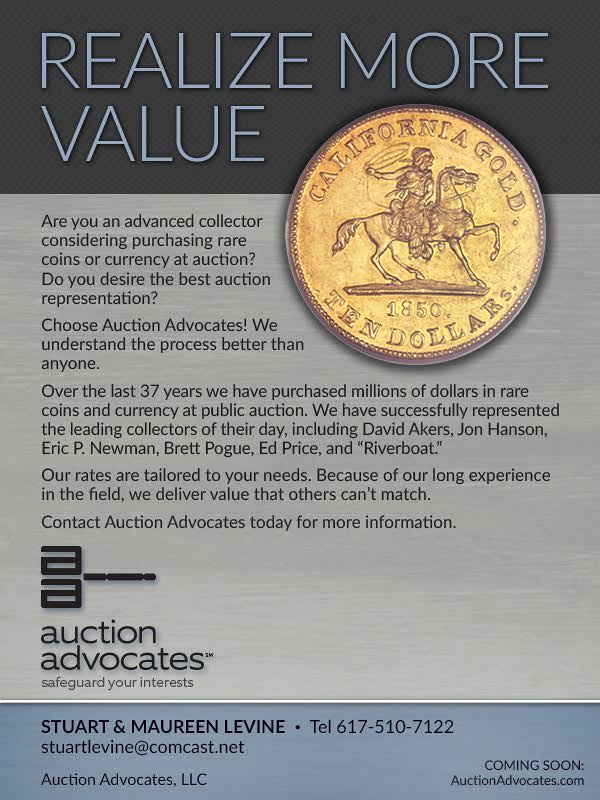
NEW BOOK: AMERICAN SILVER EAGLES, THIRD EDITION
for Bullion Program’s 30th Anniversary
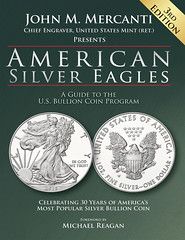 Whitman Publishing announces the release of the updated, revised third edition of American Silver Eagles: A Guide to the U.S. Bullion
Coin Program, by John M. Mercanti. The 176-page hardcover book is available online (including at www.Whitman.com) and from book stores and hobby
shops nationwide. It retails for $29.95. Because Whitman is the Official Supplier of the American Numismatic Association, ANA members receive a 10%
discount off all direct purchases.
Whitman Publishing announces the release of the updated, revised third edition of American Silver Eagles: A Guide to the U.S. Bullion
Coin Program, by John M. Mercanti. The 176-page hardcover book is available online (including at www.Whitman.com) and from book stores and hobby
shops nationwide. It retails for $29.95. Because Whitman is the Official Supplier of the American Numismatic Association, ANA members receive a 10%
discount off all direct purchases.
With more than 400 million coins sold since 1986, the American Silver Eagle is the most popular bullion program in the history of the United States. The coins are collected by numismatists, stockpiled by investors, and treasured by silver buyers nationwide and around the world. Author John Mercanti is famous as the 12th chief engraver of the United States Mint and the designer of the American Silver Eagle’s reverse. He shares his unique insight on the coins and behind-the-scenes perspective on his long career at the Mint.
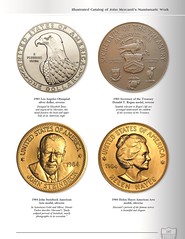
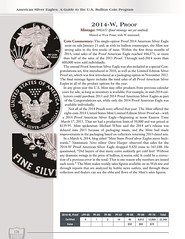
In the award-winning book’s third edition the story of the American Silver Eagle is expanded to include new information on the U.S. Mint’s individual coins and sets of 2014 and 2015. Certified coin populations and market values are updated, as are the latest mintage figures from Mint headquarters. The historical commentary has been expanded with reporting by numismatist Steve Roach. A check list and record file for collectors is an added feature. And the catalog of John Mercanti’s numismatic works has been expanded with 60% larger photographs and more illustrations.
These additions and updates, building on the solid foundation of the first and second editions, make American Silver Eagles, third edition, a valuable reference for every collector’s and investor’s library.
American Silver Eagles was the first in a trilogy of books on the U.S. Mint’s bullion coin programs. The second is American Gold and Platinum Eagles (Edmund C. Moy), and the third is American Gold and Silver: U.S. Mint Collector and Investor Coins and Medals, Bicentennial to Date (Dennis Tucker). All are available online and in book stores.
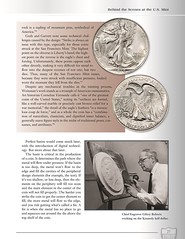
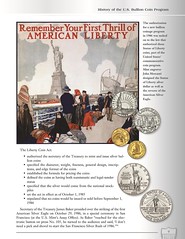
American Silver Eagles: A Guide to the U.S. Bullion Coin Program
By John M. Mercanti;
Foreword by Michael Reagan
ISBN 0794844073
Hardcover, 8.5 x 11 inches
176 pages
Full color
Retail $29.95 U.S
For more information, or to order, see:
American Silver Eagles - A Guide to the U.S. Bullion Coin Program - 3rd Edition
(www.whitman.com/store/Inventory/Detail/American-Silver-Eagles---A-Guide-to-the-U-S--Bullion-Coin-Program---3rd-Edition+0794844073)
EL SITIO NO. 18 PUBLISHED
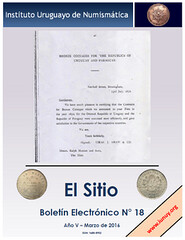 “El Sitio” N° 18 contains, in its 28 pages, three articles about different numismatic issues.
“El Sitio” N° 18 contains, in its 28 pages, three articles about different numismatic issues.
The first article, “Identificación de la letra monetaria ‘H’ de las monedas de cobre de 1869”, was written by Gustavo Pigurina and it is
related to the Uruguayan coins struck in 1869 in three monetary values: 1, 2 and 4 centésimos. Those coins have the letter H of the mint,
and Pigurina presents a document (showed in the cover of “El Sitio”) that definitively confirms that the H is the identification of the
Birmingham Mint (former Heaton Mint), not the Rochelle mint as some people have claimed.
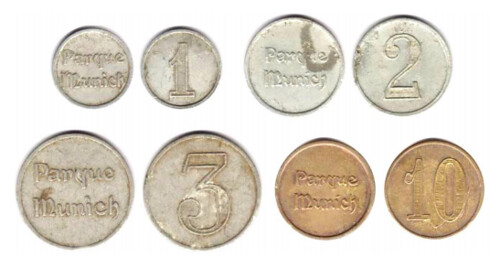
Parque Munich tokens
The second article, written by Horacio Morero Ferrero, “Las fichas (uruguayas) del Parque Munich”, presents the history and catalogues the tokens of the famous Parque Munich in Montevideo, a popular beer park during the 30, 40 and 50 years of the 20th Century. The investigation of Morero confirms the Uruguayan origin of these tokens and erases all doubts about it (they were catalogued by error as Argentinian tokens in the Rulau Catalogue).
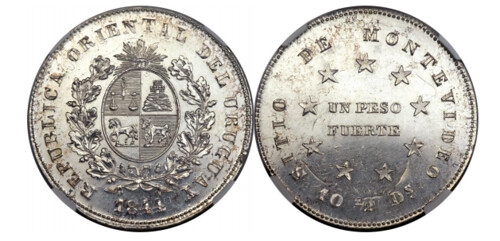
The third article reviews the circulating coins during the XVII and XVIII centuries in the “Banca Oriental” (today, Uruguay). This interesting chronicle, “La moneda circulante en la Banda Oriental y el anatema del Vicario Barrales”, was written by Pedro Damián Cano Borrego.
“El Sitio” announces as well the “Jornadas Uruguayas de Numismatica 2016”. The Jornadas welcome all international numismatic collectors and sellers and will be held this year in October 15th and 16th, in the Holiday Inn Hotel, Colonia 823, Montevideo, Uruguay.
To read the complete issue, see:
http://www.iunuy.org/designroom00/wp-content/uploads/2014/03/ElSitioN%C2%BA18.pdf
THE BOOK BAZARRE
BOOK REVIEW: COMPREHENSIVE CATALOG OF CONFEDERATE BONDS, 2ND ED.
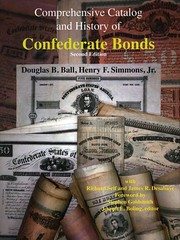 The first edition of the Comprehensive Catalog and History of Confederate Bonds was published in 1998. The book was a huge success
and brought new information and knowledge into the market. It also laid the foundation for the second edition as well as other books that will surely
come in the future.
The first edition of the Comprehensive Catalog and History of Confederate Bonds was published in 1998. The book was a huge success
and brought new information and knowledge into the market. It also laid the foundation for the second edition as well as other books that will surely
come in the future.
The second edition, written by Henry F. Simmons, Jr. with Richard Self and James R. Desabaye, will catapult and take CSA bond collecting to new heights. The book picks up where Dr. Douglas B. Ball left off creating a wonderful masterpiece. To those who are unfamiliar, Dr. Ball passed away in 2003 before he was able to revise his Confederate Bond book. To use the words of Stephen L. Goldsmith, who wrote the forward, “the torch has been passed, and it is in good hands.”
There are some minor, but important, differences from the first edition to the second. One of which is the addition of new bond discoveries and corrected errors in the Criswell-Ball cross reference (which are found in two places: the appendix and each catalog number). The second edition also has updated pricing in two grades (Fine and Very Fine), includes over 200 large color scans, and has updated Ball reference numbers.
The aspect of this book that I thoroughly enjoyed was an in-depth (20-page) introduction of sorts which contained the following sections: historical outline, approaches to cataloging, attribution, considerations for collectors (which includes a section on overt counterfeits, grading, and rarity), and descriptive details (including printing and paper types).
The last section before the “meat and potatoes” (a.k.a. the descriptive details) is by far my favorite of the Introduction to Confederate Bond section. This has some great information regarding how the bonds were printed. Special attention was paid in this edition to identify the printing technology used (letterpress, lithograph or intaglio) on each issue. Simmons, et al. clarified some confusing imprints. Several issues notate an engraver and lithographer on the same bond (B-143), while some bonds (B-296 to 340) display an engraver and a printer. Others are misleading like the B-211 bear the imprint, “Evans & Cogswell Lith. Columbia” when in fact this bond is actually printed using a letterpress technique. In this exact instance Lith. is short for lithographer and not lithograph.
Inside this fascinating book you will find 194 types of bonds broken down into varieties for a total of 386 catalog numbers, along with 15 counterfeit bond listings. There are six appendixes which cover the gambit of bond coupon signers, to Confederate legislation, to a master Criswell-Ball cross reference.
If you are a long time collector of CSA bonds or just getting into the hobby then this book will most certainly need to be on your shelf. It’s a treasure trove of information.
To read the complete article, see:
Numismatic Books – Confederate Bond
Book Review (www.coinweek.com/coins/supplies/books-2/numismatic-books-confederate-bond-book-review/)
WAYNE WILCOX (1936-2016)
 The Montgomery County Coin Club was saddened to learn that long time member Wayne Wilcox died peacefully at home on March 9, 2016 of
cancer. Wayne, a native of Mitchell, South Dakota, was known by fellow club members as a collector of Barber coinage and banknotes from his native
South Dakota. He continued to collect these banknotes to the end bringing his finds to show off at meetings. Many of us learned a lot about Wayne’s
home state.
The Montgomery County Coin Club was saddened to learn that long time member Wayne Wilcox died peacefully at home on March 9, 2016 of
cancer. Wayne, a native of Mitchell, South Dakota, was known by fellow club members as a collector of Barber coinage and banknotes from his native
South Dakota. He continued to collect these banknotes to the end bringing his finds to show off at meetings. Many of us learned a lot about Wayne’s
home state.
To read the complete article, see:
IN MEMORIUM: Wayne Wilcox
(http://mdstatenumisassn.org/MCCC/2016/03/17/in-memorium-wayne-wilcox/)

NEWMAN PORTAL INCLUDES THE COLONIAL NEWSLETTER
 Courtesy of the American Numismatic Society (ANS), the Newman Portal now features the Colonial Newsletter (CNL) from 1960 to 2015
(issues no. 1 to 159). Launched by Al Hoch and others, the CNL was ably managed for many years under editor Jim Spilman, until the Colonial
Newsletter Foundation donated the publication to the ANS in 1996.
Courtesy of the American Numismatic Society (ANS), the Newman Portal now features the Colonial Newsletter (CNL) from 1960 to 2015
(issues no. 1 to 159). Launched by Al Hoch and others, the CNL was ably managed for many years under editor Jim Spilman, until the Colonial
Newsletter Foundation donated the publication to the ANS in 1996.
Oliver Hoover, the current editor, does not shy away from provocative topics, and issue 159’s “Hidden Initials by Early American Engraver’s Guild,” which, per Hoover, “pushes the bounds of traditional interpretation,” is a must-read for anyone interested in George Washington Indian Peace Medals.
The current CNL further features serial publication of important colonial coins in the ANS cabinet. The periodical as a whole has captured the best researchers of its time - the inaugural issue featured Ken Bressett - and is indispensable for the colonial specialist. In addition, the little known Colonial Newsletter Online (12 issues published between 1995 and 1997) is also present here, as well as the most recent index of the CNL.
Link to the Colonial Newsletter on the Newman Portal: http://www.newmanportal.org/library/publisherdetail/511327
Link to the Colonial Newsletter index, 1960-2015: http://www.newmanportal.org/library/book/514024
Link to the Colonial Newsletter Online: http://www.newmanportal.org/library/publisherdetail/511377
STEVE ROACH ON ONLINE NUMISMATIC RESOURCES
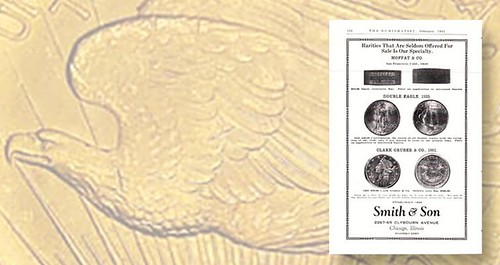
Online resources to assist collectors to buy coins and learn more about coins in their collections keep getting better. From the American Numismatic Association’s recent digitization of more than a century of its publication The Numismatist, to the Newman Numismatic Portal’s scanning of more than 100,000 pages from more than 3,000 coin-related publications, more information is available to researchers than ever before.
The largest coin firms continue to break new ground, from Professional Coin Grading Service making its PCGS CoinFacts website free to the almost continuous enhancements to Numismatic Guaranty Corp.’s website as it expands to help collectors around the world.
Stack’s Bowers Galleries announced on March 8 that it would launch an entirely new, integrated technology platform including an enhanced website along with mobile and tablet apps. As Stack’s Bowers President Brian Kendrella explained, “The new platform is completely integrated, meaning that your interaction and experience will be the same regardless of if you are accessing our auctions from your home computer or mobile device.” He added that the site will soon include an expanded want-list feature, grading service population reports, and price guides.
Perhaps most exciting to collectors is the improved sales results at the Stack’s Bowers Galleries website that currently include more than 200,000 past prices and will expand to include past Bowers and Merena, Stack’s, American Numismatic Rarities and Teletrade records. This and the Heritage Auctions archive of nearly 2 million rare coin sales and nearly half a million paper money auctions, are powerful resources that will continue to redefine provenance research for decades to come.
It’s truly an exciting time for collectors. In researching this month’s cover story on the 1933 Saint-Gaudens double eagle, I looked to the archived issues of The Numismatist from the 1940s to today, and the ads seeking examples and offering them for sale, little mentions buried in coin club meeting recaps, to broad features by hobby greats like Robert Julian, David T. Alexander and Q. David Bowers all helped me find new perspectives to share this fascinating story.
To read the complete article, see:
Auction firms, others expand the world of
online research: The Investment Column (www.coinworld.com/news/us-coins/2016/03/online-research-investment-column.html)
The 1933 Saint-Gaudens gold $20 double eagle is a coin that captures the imagination, with a story that wraps in international intrigue, glamorous auctions and legal battles, and each twist and turn seems to present more questions. It been the subject of several mainstream books, and television shows including a documentary produced for the Smithsonian Institution and an episode of The Closer. In Coin World alone since 2009 I’ve written nearly 100,000 words on a family’s quest to keep 10 examples it, allegedly discovered in a family’s safe deposit box years ago, against the government’s interest in reclaiming what it sees as stolen government property.
To read the complete article, see:
The lore and mysteries of
the 1933 double eagle continue to captivate
(www.coinworld.com/news/us-coins/2016/03/what-makes-the-1933-double-eagle-so-facinating.all.html#)

MORE ON FRANK J. KATEN
Frank Katen's "Power Wall"
Dave Bowers writes:
Nice issue. One of these times I should write something about Frank Katen, a fine numismatist I interviewed in depth a number of times. I also visited him and Laurese in DC. Completely apart from numismatics, he was in the public relations business, and both were deeply involved in DC society and politics. On one wall in his house he had his “Power Wall” showing him with DC celebrities. Wonder if this exists today, and if so, who has it? I had no idea about the name change mentioned in The E-Sylum. I learn something new every day.
Dick Johnson writes:
Like our editor Wayne Homren a decade or so later I had visited Frank Katen a number of times when he lived in Washington, DC. His library was indeed awesome. The numismatic books he sold were rubber stamped “From the Library of Frank Katen.” Undoubtedly many of these still exist.
On one visit he showed me the secret of his book dealing, a card file listing where books were published or could be obtained plus the cost. I must have said something like, “Boy would I like to have that.”
His wife (second, I believe) overheard that remark. Years later when I was editor of Coin World she called me. “Would you like that card file? I will sell it to you for a thousand dollars.” I didn’t know they were involved in a messy divorce. My allegiance was with Frank so I called him to report what she had said. It appears she was not enamored with Frank’s coin and book business.
While at Coin World we ran a special issue devoted entirely to numismatic literature. Earlier I had compiled a list of American books of numismatic interest (for John L. Ford). I updated that list and ran it twice in Coin World, a year apart.
After I left Coin World sometime later Margo Russell asked Frank to replace that list with one of his own (most of which were my original listings). But Frank undoubtedly used that card file as his update resource and changed the format of the list slightly.
Here again, it ran a couple times in Coin World, but ultimately ended up in early editions of Coin World Almanac.
His next wife, Laurese, was a delight, completely opposite of number two, as she joined in the business with Frank, often accompanying him to shows. She collected medals and I always had something new for her when we both attended the same show.
The last time I saw Frank was when he conducted the library sale of George Fuld, November 1973. I bought heavy in his auction, and in retrospect, wish I had bought far more.
To read the earlier E-Sylum article, see:
FRANK J. KATEN, (1903-2001) (www.coinbooks.org/esylum_v19n11a11.html)
HARRY SHEPHERD VAN DENBERG (1885-1963)
Harry Shepherd Van Denberg (1885-1963), was born on May 7,1885, son of LaGrange Van Denberg (1857-) and Mary Esther Shepherd (1861-) at Charles City, Iowa. As a young boy he collected coins and stamps. By 1899 his family moved to Webster City, Iowa, where young Harry ran a mail order stamp business, the Vandenberg Stamp Company.
He moved to Rockford, Illinois about 1905 working as a bookkeeper for the Wayburn Company. In 1906 he joined the American Philatelic Association. On January 15, 1906 he began working for Fred K. Houston owner of American Heating Company, a plumbing, heating and janitorial supply company.
In 1920 he became independent with his own form Van Denberg Supply Company. In 1920 he became independent with his own form Van Denberg Supply Company run by he and his wife Alice. Alice died on March 2, 1935. He retired from the plumbing supply business in January 1946.
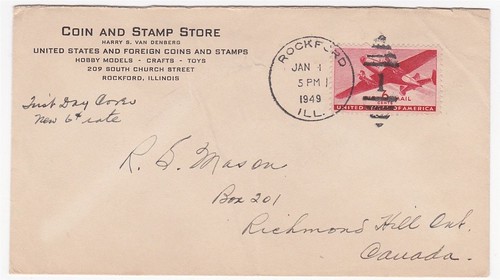
Since 1946 he was the owner of the Coin and Stamp Store, 209 South Church Street, Rockford, Illinois. His store was the new emerging Hobby Shop phenomenon in America, a spin off of the Old Curiosity Shop, instead of old books, artworks and antique and antique novelty items they sold instead models, crafting supplies, toys, as well as coins and stamps.
According to Numismatic Scrapbook, in 1948 he called the ANA auction at Boston, Massachusetts held by Frank J. Katen.
In 1954 he attended the ANA Convention at Cleveland, Ohio.
In the 1960’s he called his shop the Rockford Coin & Stamp Store in his ads in Numismatic Scrapbook. His last ad ran posthumously in March 1963.
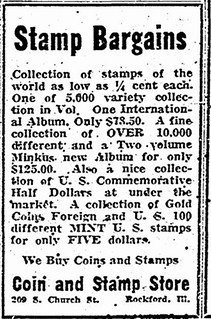
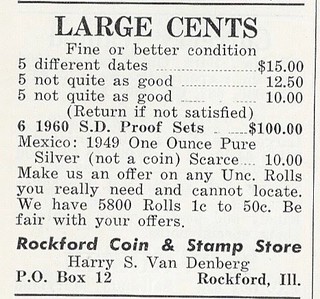
He suffered from cancer of the throat and mouth. He committed suicide by a self-inflicted gunshot wound to escape the pain and suffering of his cancer. He died on February 26, 1963, at the age 77 years old. He was buried at Willwood Burial Park, Rockford, Illinois, on March 1, 1963.
To read the complete article, see:
VAN
DENBERG, HARRY SHEPHERD
(https://sites.google.com/site/numismaticmallcom/encyclopedic-dictionary-of-numismatic-biographies/van-denberg-harry-shepherd)
THE BOOK BAZARRE
NOTES FROM E-SYLUM READERS: MARCH 20, 2016
Frank Lapa Fantasy Coin Catalog Sought
Leon Saryan writes:
Here's a query for our E-Sylum readers. Reading about the fantasy ancient coin found in Kentucky jogged my memory. A while back you ran a discussion about the strange story of Frank Lapa, who concocted fantasy coins for a number of obscure countries. Has anyone ever prepared a list of Lapa fantasies?
To read some earlier E-Sylum articles on Lapa, see:
MORE ON THE FRANK LAPA/RAY YABLUM MURDER CASE
(www.coinbooks.org/esylum_v09n31a32.html)
QUERY: INFORMATION ON FRANK LAPA'S RUSSIAN WIRE MONEY REPLICAS SOUGHT
(www.coinbooks.org/esylum_v16n09a25.html)
MORE ON FRANK LAPA'S REPLICAS
(www.coinbooks.org/esylum_v16n10a12.html)
Roper Sale 1836 gold Dollar Pattern
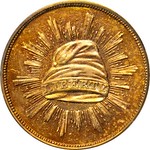 Saul Teichman writes:
Saul Teichman writes:
With regard to the 1836 gold dollar pattern, there is an earlier sale the 1855 one noted. The earliest auction appearance I am aware of was actually the February 1851 Lewis Roper sale lot 11 sold to Ammi Brown for $2 and 3 bits.
To read the earlier E-Sylum article, see:
SELECTIONS FROM STACK'S BOWERS MARCH 2016 RARITIES SALE : Lot 13247: 1836
Pattern Gold Dollar (www.coinbooks.org/esylum_v19n11a17.html)
French Southeast Asia Coins & Currency
I asked Howard Daniel for more information on the book he's writing. He writes:
It's on French Southeast Asia Coins & Currency. It covers the French issues in Southeast Asia from the early 1800s in the East Indies to the end of their control of the Indochina area at the end of 1954.
To read the earlier E-Sylum article, see:
WAYNE'S NUMISMATIC DIARY: MARCH 13, 2016
(www.coinbooks.org/esylum_v19n11a16.html)
Half Dollars Still Circulating in Reno, NV
Regarding the U.S. Half Dollar, Paul K. Williams writes:
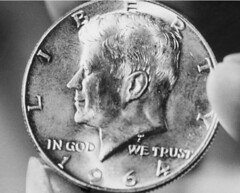 I’m life member 1886 of the ANA, past president of the Reno Coin Club, a lifelong coin collector and didn’t know we stopped making half
dollars. Here in Reno Nevada we use half dollars in the low limit hold’em and Omaha games and the dealers set them aside for me and I pay them full
silver value. Just yesterday a dealer sold me one 90% and eight 40% clads. He said, “I guess this is the last time” and I said “Why do you say that?”
He said, I haven’t seen any silver ones in about a year. But I am shocked we haven’t made any in years. Just to let you know we still use them in
Reno.
I’m life member 1886 of the ANA, past president of the Reno Coin Club, a lifelong coin collector and didn’t know we stopped making half
dollars. Here in Reno Nevada we use half dollars in the low limit hold’em and Omaha games and the dealers set them aside for me and I pay them full
silver value. Just yesterday a dealer sold me one 90% and eight 40% clads. He said, “I guess this is the last time” and I said “Why do you say that?”
He said, I haven’t seen any silver ones in about a year. But I am shocked we haven’t made any in years. Just to let you know we still use them in
Reno.
To read the earlier E-Sylum article, see:
THE HALF-DOLLAR’S ACCIDENTAL DEMISE
(www.coinbooks.org/esylum_v19n11a15.html)
WWII Australian Refugee Camp Note Messages
Regarding the WWII Australian refugee camp notes discussed in our March 6, 2016 issue, Jeff Starck of Coin World writes:
If someone has not pointed it out, you can squint and see the special message appearing around the design on these notes. It reads WE ARE HERE BECAUSE WE ARE HERE BECAUSE WE ARE HERE. It is an understandable lament at the presence of these mostly Jewish people of their unchosen residence in the camp.
Other hidden messages appear on the note designs, as detailed further in our October 11, 2011 story at CoinWorld.com.
These are fascinating bits of numismatic – and, dare I say it -- world history. If only I could afford one!
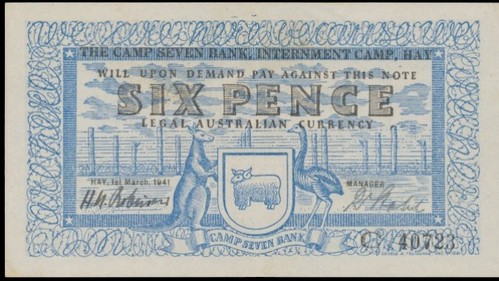
To read the Coin World article, see:
Internment camp bank note
highlights Downies auction (www.coinworld.com/news/paper-money/2011/10/internment-camp-bank-note-highlights-downies-.html)
To read the earlier E-Sylum article, see:
AUSTRALIA WWII REFUGEE CAMP SCRIP NOTES OFFERED
(www.coinbooks.org/esylum_v19n10a30.html)
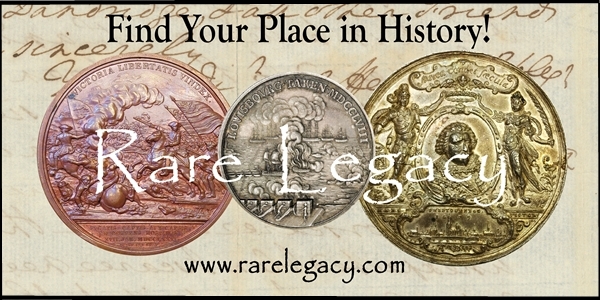
HIKER FINDS RARE 2,000 YEAR OLD GOLD COIN
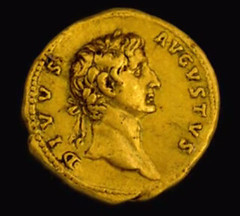 A random discovery recently made by a hiker at an archeological site in the eastern Galilee turned out to be only the second known gold
coin of its kind in the world, the Israel Antiquities Authority announced on Monday.
A random discovery recently made by a hiker at an archeological site in the eastern Galilee turned out to be only the second known gold
coin of its kind in the world, the Israel Antiquities Authority announced on Monday.
The 2,000-year-old relic, bearing the image of Emperor Augustus, was minted by Emperor Trajan as part of a series of nostalgic coins he dedicated to the Roman emperors who ruled before him.
Until the coin was found by Laurie Rimon, a member of Kibbutz Kfar Blum who was hiking with friends, the only other known version was on display at the British Museum, the IAA said.
“Laurie discerned a shiny object in the grass,” the authority said in a statement.
“When she picked it up, she realized it was an ancient gold coin.”
In short order, the group’s guide, Irit Zuk-Kovacsi, contacted the IAA with the help of archaeologist and veteran tour guide Dr. Motti Aviam, and within two hours a representative met the group in the field to analyze the object.
“This coin, minted in Rome in 107 CE, is rare on a global level,” said Dr. Danny Syon, a senior numismatist at the authority. “On the reverse, we have the symbols of the Roman legions next to the name of the ruler Trajan, and on the obverse, instead of an image of the emperor Trajan, as was usually the case, there is a portrait of the emperor Augustus Deified.”
According to Dr. Donald T. Ariel, head curator of the IAA’s coin department, the artifact could reflect the presence of the Roman army in the region some 2,000 years ago, possibly in the context of activity against Bar-Kochba supporters in the Galilee, although it is “very difficult to determine that on the basis of a single coin,” he said.
“So far, only two other gold coins of this emperor have been registered in the State Treasures, one from Givat Shaul near Jerusalem, and the other from the Kiryat Gat region, and the details on both of them are different from those that appear on the rare coin that Laurie found,” he said.
For her part, Rimon said that returning the rare find was bittersweet.
“It was not easy parting with the coin,” she said.
“After all, it is not everyday one discovers such an amazing object, but I hope I will see it displayed in a museum in the near future.”
Bill Rosenblum writes:
I'm not sure if the claim that this is only the 2nd one known is correct because RIC and BMC illustrate different coins.
To read the complete article, see:
Hiker finds rare
2,000-year-old gold coin in northern Israel
(www.jpost.com/Israel-News/Hiker-finds-rare-2000-year-old-gold-coin-in-northern-Israel-447848)
COINS OF THE TWELVE CAESARS
Julius Caesar
ARISTOCRATIC ROMANS USUALLY BORE three names. For example, Gaius Julius Caesar (born 13 July 100 BCE), son of Gaius Julius Caesar (died 85
BCE) belonged to the Caesares family of the large Julian clan (gens Julia in Latin). Young Julius would live to make the name “Caesar” not
merely famous, but a title for emperors and their sons; a title that would endure for millennia, becoming Kaiser in German and Tsar in
Russian.
In 63 BCE he was elected Pontifex Maximus, high priest of the Roman state religion.
Between 58 and 50 BCE Caesar conquered the Celtic tribes of Gaul, bridged the Rhine to fight the Germans and launched an expedition across the Channel into Britain.

In 49, he began a civil war against the Roman Senate.
To pay his armies he struck an immense issue of silver denarii bearing his name beneath an elephant on the obverse, and his “priestly implements” used in rituals on the reverse. These are by far the most common coins in Caesar’s name.
Romans, who had overthrown their kings in 509 BCE to establish the Republic, were uncomfortable with the idea of depicting a living person on the coinage. In January 44 BCE, the first portrait coins in the name of Caesar were issued, with only the title IMP (for Imperator, which at this period meant only military commander-in-chief).
A month later, portrait coins were struck with the title DICT PERPETUO (“Dictator for Life”). There are several variants of this type, bearing names of different mint officials (“moneyers”).
For the conservative faction in the Senate, this was the last straw. On 15 March 44 BCE Caesar was stabbed to death.
None of Caesar’s gold coins bear his portrait; many depict an uncertain female goddess (possibly Vesta). A particularly rare example struck by a military mint moving with Caesar’s army in 48-47 BCE sold for over $US300,000 in a recent European auction.
Octavius, called Augustus
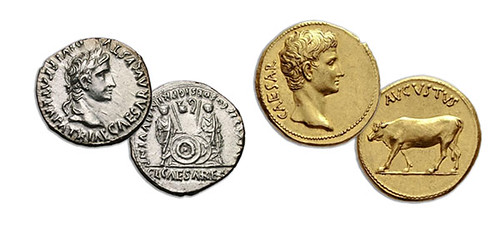
The assassination of Caesar renewed the civil war, which ended 17 years later when his great-nephew Octavius received the title of “Augustus” from the Senate.
Gaius Octavius, son of Gaius Octavius, was born 23 September 63 BCE. His mother Atia was the daughter of Julia, sister of Julius Caesar. When Caesar was murdered Octavius was 18 years old, studying in Illyria (now Albania). He learned that he was Caesar’s adopted son and heir when he returned to Italy.
Since Caesar had been deified (posthumously declared a god by the Senate on 1 Jan 42 BCE), Octavius used the title DIVI F (Divi filus “Son of a God”) on his imperial coinage. The most common silver issue of his long reign was struck between 2 BCE and 4 CE; it features a reverse depicting his grandsons and designated heirs, Lucius and Gaius. Unfortunately, Lucius died in 2 CE and Gaius died two years later, both possibly poisoned.
Tiberius, the son of Octavius’s wife Livia by a previous marriage, succeeded him.
On much of his elegant gold coinage the only inscription is the word AUGUSTUS. Although he lived to the age of 75 (remarkable for that era), his coin portrait remained youthful and idealized. A superb aureus of Augustus, with a reverse depicting a heifer, sold for nearly US$400,000 in a recent European auction.
To read the complete article, see:
CoinWeek Ancient Coin Series: Coins of
the Twelve Caesars (www.coinweek.com/ancient-coins/coinweek-ancient-coin-series-coins-twelve-caesars/)
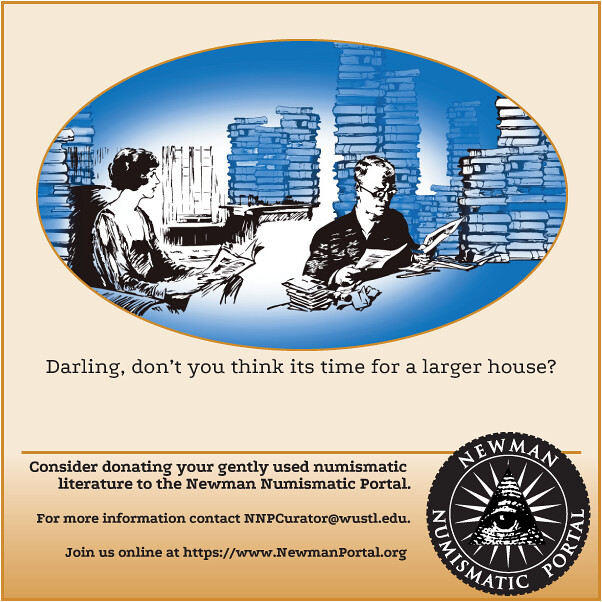
1646 DUTCH COLONIAL BRAZIL SIEGE COIN
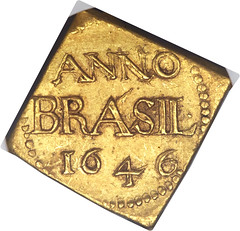
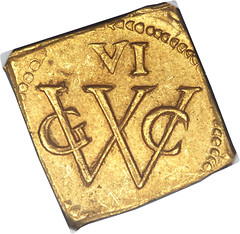
Our upcoming April 14-19 CICF World Coins & Ancient Coins Signature Auction in Chicago features an extremely rare 1646 6 Guilders issue from the Geoctroyeede West-Indische Compagnie in Brazil. The strike is crude, as with all the Pernambuco gold issues, but all of the legends, denomination, and date are full and bold. At MS62, as graded by NGC, this is a nice Mint State example of this elusive series.
The Dutch invaded the northeast coast of Brazil in 1630 with the intention of establishing a colonial presence in South America. For the initial 2 years, the Dutch remained cornered in "Fort Orange" and under constant attack by the Portuguese. The Geoctroyeede West-Indische Compagnie (GWC), a company created by the Dutch to "manage" their operations in Pernambuco, was considering abandoning Brazil all together when in 1632 when the Portuguese commander, Domingos Ferreira Calabar defected from the Portuguese army and joined the Dutch. With Calabar, the Dutch expanded their position north of Pernambuco adding several important towns on their way.
The Dutch troops consisted mostly of mercenary soldiers there simply to fight than money. At this time, mostly Hispanic American and Portuguese coins circulated in Dutch Brazil. The Dutch brought their own money, the Guilder, which by the mid 1640's was extremely scarce and when the galleon "Zeeland" ported in the city of Recife, with gold from the Dutch post in Guinee, Africa, the GWC took a "share" of the precious metal. The company was near a desperate state, constantly cornered and under attack, and used the gold taken from the "Zeeland" to strike in September of 1645, three denominations; 3, 6 and 12 Guilders.
There are no records of the exact numbers of coins that were struck in 1645 but scholars estimate between 1500 and 2000 of each denomination. The important fact is that coins struck in Brazil were not legal tender in Holland and any coins coming back to Europe had to be exchanged for Dutch Guilders (and this is why the Brazilian issue was referred to as the Brazilian Ducat) and subsequently were melted. In the colony, any Portuguese or Brazilian found with a Dutch coin ran the risk of being considered a traitor and hanged. So any coins staying behind in Brazil would have been melted after 1654 after the Dutch were finally ousted from South America. The fact is that very few coins remain of both dates and all three denominations. Our best estimate would be around 50-60 pieces, all together, and a number in museum collections.
To read the complete lot description, see:
Pernambuco. Geoctroyeede West-Indische Compagnie (GWC)
(http://coins.ha.com/itm/brazil/pernambuco-geoctroyeede-west-indische-compagnie-gwc-gold-6-guilders-florins-1646-ms62-ngc-/p/3046-14001.s?)
1794 BATTLE OF THE GLORIOUS FIRST OF JUNE MEDAL
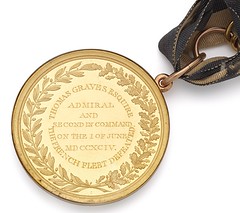 An extremely rare gold medal commemorating the victory of the British Fleet at the Battle of the Glorious First of June in 1794 during the
French Revolutionary Wars is to be sold at Bonhams Medals, Bond, Banknotes and Coins sale in London on 23 March. It is estimated at
£140,000-160,000.
An extremely rare gold medal commemorating the victory of the British Fleet at the Battle of the Glorious First of June in 1794 during the
French Revolutionary Wars is to be sold at Bonhams Medals, Bond, Banknotes and Coins sale in London on 23 March. It is estimated at
£140,000-160,000.
The medal was awarded to Admiral Lord Graves as captain of HMS The Royal Sovereign and was one of only seven large gold medals struck to mark the victory.
Bonhams Director of Coins and Medals, John Millensted said, “This is an incredibly scarce and desirable medal in excellent condition and its rarity is reflected in the high estimate. I expect it to have wide appeal to collectors all over the world.”
The Battle of the Glorious First of June was the culmination of months of indecisive skirmishing between the British Navy and the Atlantic Fleet of Revolutionary France. The encounter was sparked by British attempts to prevent a grain convoy from America reaching France. The population was facing the threat of starvation as a result of poor harvests and the successful blockading of many French ports.
Although both sides suffered losses and the grain convoy got through, the victory - both on the day and in the longer term - belonged to the Royal Navy. The French fleet limped back to its home port of Brest in Brittany and was blockaded there until the French Revolutionary Wars finally ended in 1802. The defeat inflicted severe damage on the prestige of the French Navy in the eyes of the country’s military command and led to a gradual decline that culminated in comprehensive defeat at the Battle of Trafalgar in 1805.
To read the complete article, see:
Exceptionally rare
naval large gold medal for sale at Bonhams
(http://artdaily.com/news/85857/Exceptionally-rare-naval-large-gold-medal-for-sale-at-Bonhams#.Vu28FfkrKhc)
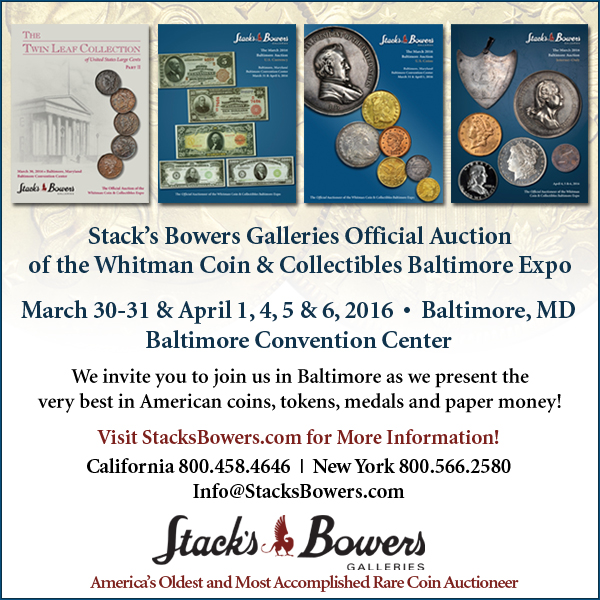
JACOB PERKINS AND NEWBURYPORT COINAGE LECTURE
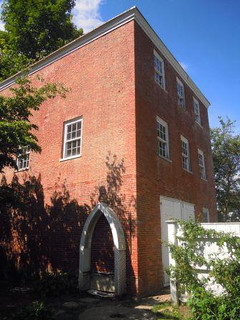 On Wednesdays, March 23 and 30, join one of the area’s most knowledgeable numismatists, Rick Bagg, as he leads a presentation about local
coins. At the auction firm where he spent his career, Rick handled several hundred million dollars in coins for thousands of clients.
On Wednesdays, March 23 and 30, join one of the area’s most knowledgeable numismatists, Rick Bagg, as he leads a presentation about local
coins. At the auction firm where he spent his career, Rick handled several hundred million dollars in coins for thousands of clients.
Jacob Perkins figures prominently in Newburyport history as an inventor and entrepreneur. Perkins printed currency for much of New England and engraved the first cent to circulate in Massachusetts. His original engraving plant is located to the rear of the Cushing House. Perkins's genius reached beyond New England, and he printed to first stamp ever manufactured, the penny black, which was used in England.
Attendees are encouraged to bring their own historic coins for discussion, and Rick will also bring samples of money made and used locally. This program will run twice, once on March 23 and once on March 30.
March 23 and 30
12:15-1:00pm
Please RSVP to 978-462-2681 or info@newburyhistory.org
Members: Free
Non-Members: $5
Dick adds:
In the category of “my timing sucks”, I will be arriving in Newburyport about 6 hours after the first presentation (Rick Bagg), and be in northern Maine (way too far to drive back and forth) for the second.
For more niformation on the Museum of Old Newbury and the Perkins Printing and Engraving Plant, see:
www.newburyhistory.org

U.S. MINT REGAINS DISPUTED 1974-D ALUMINUM CENT

The United States Mint announced today that it has recovered a 1974-D aluminum experimental one-cent specimen that was neither authorized to be struck nor authorized to leave the Mint. The Mint’s recovery follows an agreement to resolve a lawsuit over the ownership of the piece.
The lawsuit in question involved an aluminum one-cent specimen that had once been in the apparent possession of a former assistant superintendent at the United States Mint in Denver, Co. The two plaintiffs, an heir of the former assistant superintendent and a California coin dealer, filed suit in federal District Court in San Diego, Ca., seeking a declaratory judgment that the piece was legal to own.
Over 1.4 million of the experimental pieces were struck at the Mint in Philadelphia in 1974 as part of a test program to possibly replace copper one-cent coins. However, Congress never enacted legislation authorizing the Mint to issue one-cent coins composed of aluminum, and the test pieces were to all be melted. The specimen piece in question bears a “D” mark, signifying production in Denver, along with the date “1974,” and appears to have been struck with a die intended for the Mint’s Denver facility. However, authority was never granted for production of the experimental test pieces at Denver.
An heir of the now-deceased former assistant superintendent contended that his father was given the aluminum one-cent specimen as a gift upon his retirement. The heir provided the piece to an auction firm and hoped to sell it. In February 2014, the United States Mint became aware of plans to offer this particular piece for auction, and immediately reached out to the plaintiffs, notifying both that the United States Mint never issued, nor otherwise transferred title to any aluminum one-cent piece, and that indeed, lawful authority to issue them was never granted. Congress never divested the government's interest in the subject aluminum one-cent piece, and accordingly, it remained the rightful property of the Federal government.
The Mint, upon authorization of the Secretary of the Treasury and as delegated by Congress, has the exclusive authority to mint and issue U.S. coins and other numismatic items. Items made at United States Mint facilities but not lawfully issued—or otherwise lawfully disposed of—remain government property and are not souvenirs that Mint officials can remove and pass down to their heirs.
The agreement directs that title to the piece rests with the United States Mint and that it be transferred to its custody and control. Mint Police have secured the piece. The Mint considers the specimen to be a valuable historic heritage asset. Accordingly, it intends to display the specimen publicly so that this heritage asset can be properly showcased and enjoyed by numismatists, coin collectors and the general public. The display forum has not yet been decided, but the Mint will make an announcement when a decision has been made.
“The Mint is very pleased with the agreement, and we are very grateful to the U.S. Attorney’s Office in San Diego for its work and efforts in reaching this resolution. We look forward to displaying the coin appropriately as an important Mint heritage asset,” said Rhett Jeppson, United States Mint Principal Deputy Director. “This agreement is not only good for the integrity of the coin collecting hobby but for the integrity of the government property and rule of law.”
Dick Johnson forwarded this story about the finder of the cent in The San Diego Union-Tribune. Thanks! -Editor
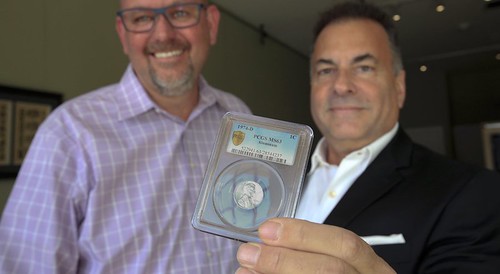
Michael McConnell and Randy Lawrence
Real estate agent Randy Lawrence, who had unknowingly kept the treasure in a sandwich baggie for decades, and La Jolla Coin Shop owner Michael McConnell had planned to auction the coin for at least $250,000 and had fought off the U.S. Mint’s efforts to seize the penny.
But a key deposition a few months ago, indicating the penny was never part of an authorized pressing and might have been struck as a practical joke at the Denver Mint, made them change their minds.
“It belongs back in their hands,” Lawrence said, hours before the handoff.
But all is not lost, as Lawrence and McConnell see it. Through the legal fight, the origins of the penny have emerged.
“We’ve added to the history, the legacy, of this coin,” McConnell said. “At least we know more about this story.”
Lawrence’s father, Harry, was deputy superintendent of the Denver Mint. Lawrence claims that as part of his retirement gift, his father was given a 1974-D aluminum penny, the “D” signaling it was pressed in Denver. But there was no official record of authorization to strike such pennies there.
In his deposition, Alan Goldman, former interim Mint director who headed the aluminum cent project at the time, speculated that the Denver penny might have been made as part of a practical joke, and even has a suspect in mind.
That person, whose name has not been released, is now deceased, as is Lawrence’s father, and the complete story of the penny may have gone with them.
“I knew Harry Lawrence very well and he was a straight shooter,” Goldman said in his deposition. “He would not have engineered this.”
In any event, Lawrence’s father apparently thought the penny was worth more in sentimental value than dollar value and never told his family about it.
For decades after his father’s 1980 death, the coin sat in a baggie in Lawrence’s desk drawer along with other out-of-state coins. When he moved his family from the Denver area to San Diego in late 2013, he was introducing himself as a real estate agent to La Jolla businesses along Girard Avenue when he stepped into the La Jolla Coin Shop. A while later he brought in his father’s coin collection, which he’d been hauling around in the trunk of his car, ready to part with the inheritance.
At first glance, McConnell thought the aluminum penny was made by a foreign mint, and valued it at $300. But then he began to suspect it was what it was. He paid $2,000 to have it authenticated and certified, then contacted Lawrence with the surprising news of its rarity.
The pair said they could have tried to sell the coin privately and quietly, and it may have gone for a couple million dollars.
In 2014, the Mint claimed its right to the coin, arguing it was clandestinely struck and federal government property that was unlawfully removed. The men responded by suing the government.
On Thursday, the case was resolved when the men delivered the coin to the U.S. Attorney’s Office in downtown San Diego.
Assistant U.S. Attorney Joseph Price said authorities have never found any evidence that the penny was given as a retirement gift to Harry Lawrence.
“There are no free samples working at the Mint. (It) doesn’t entitle someone to take government property or pass it down to their heirs,” Price said.
What happens to the penny now, and whether it will end up in Denver, Washington, D.C., or elsewhere, remains to be determined.
“We look forward to displaying the coin appropriately as an important Mint heritage asset,” Rhett Jeppson, U.S. Mint principal deputy director, said in a statement. “This agreement is not only good for the integrity of the coin-collecting hobby but for the integrity of the government property and rule of law.”
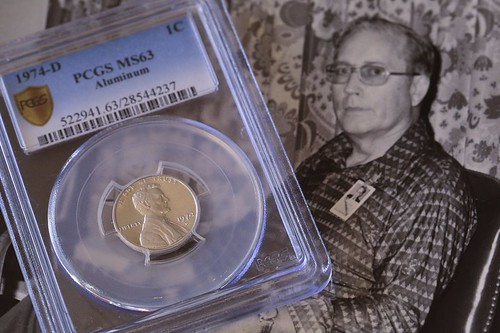
Harry Lawrence
To read the complete article, see:
Rare aluminum penny goes back to
feds (www.sandiegouniontribune.com/news/2016/mar/17/1974-aluminum-penny-mint-settlement/)
To read the earlier E-Sylum articles, see:
MAN CAPTURES UNICORN: 1974-D ALUMINUM CENT
(www.coinbooks.org/esylum_v17n05a11.html)
ON THE LEGALITY OF OWNING ALUMINUM CENTS
(www.coinbooks.org/esylum_v17n06a17.html)
GOVERNMENT DISPUTES 1974-D ALUMINUM CENT OWNERSHIP
(www.coinbooks.org/esylum_v17n12a17.html)
FIGHT CONTINUES OVER 1974-D ALUMINUM CENT
(www.coinbooks.org/esylum_v17n36a27.html)

HOW DENNIS TUCKER GOT STARTED IN NUMISMATICS
I got hooked on coin collecting when I was about seven years old. My older brother Mike—who had started his service in the U.S. Marines when I was starting kindergarten—showed me a 1937 Buffalo nickel from his collection, and we looked it up together in a copy of the Red Book. That old nickel was about the neatest thing I’d ever seen. I was intrigued by the idea of grading (“Very Good” was better than “Good,” but not as good as “Fine”), and coin values being tied to their condition, and all the cool old designs (especially colonial coppers). Mike let me keep the nickel—the first coin in my collection. I still own it! It launched a lifelong interest that became a fun hobby and, later, my career.
We all have our tale of “How I got started collecting.” Mine is that Buffalo nickel and those quiet moments of shared study with my big brother. I’ve told this story many times over the years.
Fast-forward several decades. A few weeks ago we had a mini family reunion. Several of us met at a hotel in Florida to get ready for a Caribbean cruise.
 Guess what my brother brought along.
Guess what my brother brought along.
A book.
Could it be what I thought it was? I knew the moment he showed me.
“I was going through some of my stuff and I found that old Red Book,” Mike told me. “The one you’re always telling people about.”
There it was in all its maroon-covered glory! Like a long-lost friend. 30th edition, dated 1977 (published in 1976), with the Bicentennial dollar, half dollar, and quarter designs on the front.
“Sentimental value” . . . “nostalgia” . . . I struggle to find the words for the feelings wrapped up in this old Red Book. It opened the world of American numismatics to me. Needless to say, it has a special and permanent place in my library.
To read the complete article, see:
My Numismatic “Origin
Story”—And a Nice Surprise, Thirty-Plus Years Later
(http://news.coinupdate.com/my-numismatic-origin-story-and-a-nice-surprise-thirty-plus-years-later/)
UNDER-RESEARCHED AREAS OF NUMISMATICS
Roger Buenger writes:
Recently reading the masterful work on Eric P. Newman's life as a numismatic scholar ("Truth Seeker: The Life of Eric P. Newman") and then having gone through my own numismatic library, I've begun to wonder what frontiers are left out there for numismatists to explore?? I own dozens of wonderful books that seem to tell it all. Databases such as the Eric P. Newman Numismatic Portal, Coin Facts and others provide volumes of information.
When I think of a particular area or series, I can quickly find a guide or text devoted to it that seems to comprehensively explain even the smallest details. Are there still topics to explore? Where are the mysteries? What is left to be discovered?
I have a couple of ideas but will withhold them initially to see what everyone else comes up with.
Sonorandesertrat writes:
Just considering U. S. numismatics, there is room for at least another 100+ books. Some topics that are not well understood by collectors include:
1. Pioneer & territorial gold. Much has happened since Kagin's book came out, and much of the information that John Ford 'contributed' needs to be re-examined.
2. 'Midnight minting' issues, going back into the 19th century.
3. A book focusing on the design of coins, including making the transition from plaster/wax models to dies and adapting artists' design concepts to make them more practical.
4. Differences in everyday coin circulation in various parts of the country, especially in the 19th century. Archaeological excavations have uncovered many interesting items in this regard.
5. The early half of the 20th century saw the rise of a number of very influential dealers, like Mehl, Raymond, Elder, Kosoff, who played major roles in shaping collector tastes.
6. A comprehensive book, with high-quality images, that teaches collectors how to spot altered coins. The ANA text is not good enough, in my opinion.
7. A comprehensive book on coin chemistry and metallurgy, covering redox reactions, alloying, surface treatments, natural and artificial toning (including color images of what results from various treatments), etc.
8. The politics of coin making: selection of coinage metals, changing designs, where to locate mint facilities, etc.
9. The use of Spanish Colonial coinage outside of Spanish territories (i.e, U. S., Canada, U.K., Australia, etc.).
10. Counterfeits (including electrotypes) made to fool collectors.
11. Coins and ingots recovered from shipwrecks in U. S. waters: what they teach us.
12.Medals, tokens, and other types of exonumia: plenty of room for more books.
DCW writes:
I think the area of medals and tokens offers the most for exploration and research. It is also an area that can be extremely satisfying, always offering up something new. Merchant tokens and store cards offer an almost unlimited research opportunity for the numismatic detective. Military post exchange tokens is another under-researched topic with plenty of room to tell history.
Even civil war tokens lend to new discoveries ever year in a field that has been documented in some way ever since they were minted. Mysteries abound, and you don't have the usual stiff competition from the date/mint mark collectors
Nap writes:
I can think of several European areas of numismatics where the standard references are >100 years old, have not been comprehensively updated, and/or do not exist in the English language.
TopographicOcea writes:
Reminds me of the idea to close the US Patent Office at the end of the 19th century thinking that there wasn't anything left to discover.
To read the complete discussion thread, see:
Topic Title: What areas of numismatics are
"under" researched? Is there anything left to discover?
(https://forums.collectors.com/messageview.aspx?catid=26&threadid=960449&enterthread=y)

MORE ON MILTON BRADLEY’S EDUCATIONAL TOY MONEY
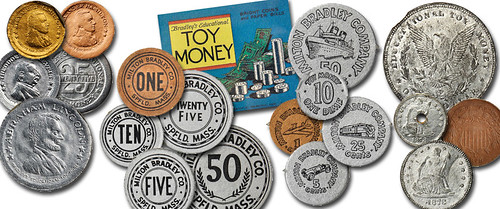
In my last exonumia article I discussed Milton Bradley's first three types of play money. In this edition I will describe the three more as well as one set of that is often incorrectly attributed to Milton Bradley.
The fourth iteration of play money that Milton Bradley made was a significant departure from their previous printed styles in that thin foil was wrapped over a small sheet of cardboard, and then pressed with rectangular dies to bring up the design over multiple "coins" that could then be punched out of the sheet. Further, the number of denominations produced was vastly reduced, with the cent, nickel, dime, quarter and half dollar alone making the cut. The obverses depict the bust of a right facing U.S. president (Hamilton, Roosevelt, Jefferson, Washington or Lincoln respectively), with BRADLEY's EDUCATIONAL TOY MONEY below.
The reverses display the numeric denomination at center and BRADLEY'S EDUCATIONAL / TOY MONEY around the periphery. The cent had either a copper or gold foil overlay, while all the other denominations had silver. Unfortunately, it seems there was difficulty in producing these consistently well, and the author has seen numerous examples with their designs in extremely low relief. The foil covering is also quite delicate, with some examples seen today missing the foil altogether! Perhaps for these reasons few of these sets were produced, as this is another type that is infrequently encountered. The box is quite simple with a two-tone red cover featuring stacks of coins and bills.
The next type goes back to the more familiar printed standard with black ink on cardboard. These types are again produced in the cent through half dollar denominations and keep the proper diameters. No dates are present on the coins, and they bear the denomination on both sides, once in text and once with numerals over crossed stalks of grain. Around the peripheries of both sides is printed MILTON BRADLEY CO. / SPFLD. MASS. As seen previously, copper-colored cardboard is used for the cent, while the other denominations are printed on silver cardboard. The box bears an image similar to the previous set, but is presented in bright colors, and advertises the set as containing "Bright coins and paper bills." Though by no means common, this set is more common than the first, second and fourth types discussed in this series.
The last type of play money produced by Milton Bradley is predictably the most frequently encountered and can be located without too much difficulty. The diameters are again true to the coins they imitate, and they are produced with black ink printed on copper and silver-colored cardboard. The denominations remain cent through half dollar. The obverse of each bears a different mode of transportation, the denomination below and MILTON BRADLEY COMPANY around the periphery. The reverse bears the denomination at center, TOY MONEY above, and the denomination in text below. Several different boxes exist for this set, but the most modern the author has seen bears a photograph of the actual bills and coins and the familiar Milton Bradley logo still in use today.
The final set discussed is not part of the Milton Bradley series at all, but is often incorrectly grouped with it. It is also easily some of the rarest play money the author is aware of. Produced by the Walkley Company, this group of play money, like the first set discussed in this article, was also pressed with dies on cardboard covered with copper or silver foil. Unlike that set, however, these have their designs boldly defined, and the metallic overlay is generally rather secure. Each coin bears the date 1878 and quite closely resembles the coins of the era. The Indian cent has EDUCATIONAL TOY MONEY around the periphery on the obverse, whereas the other denominations: two-cent piece, Shield nickel, Liberty Seated dime, Liberty Seated quarter, Liberty Seated half dollar, and Morgan dollar all have the legend on the reverse. The dollar also bears PRO BONO PUBLICO at the top obverse periphery.
Of particular interest, the author has encountered examples at several different times with the centers punched through, no doubt to ensure the coins did not pass as genuine currency. The concern of counterfeit coins would be laughable today, but in the early to mid-nineteenth century it was a genuine problem. Indeed, 50 cents could be close to a full day's wages, especially for a non-skilled worker. So prevalent was the problem, numerous counterfeit detection devices and scales were produced to assist the shopkeeper or banker, and collecting counterfeit half dollars is a popular specialty today, precisely because so many examples exist!
To read the complete article, see:
Milton Bradley’s Educational Toy Money, Part Two
(www.stacksbowers.com/News/Pages/Blogs.aspx?ArticleID=2013)
To read the earlier E-Sylum article, see:
MILTON BRADLEY’S EDUCATIONAL TOY MONEY
(www.coinbooks.org/esylum_v19n06a25.html)
SELECTIONS FROM HERITAGE NEWMAN INTERNET PART 1 SALE
The first in a series of Internet-only currency auctions is now available for preview on the Heritage Auctions website. Bidding opens on April 6 and closes May 4, 2016. The sale features Colonial, Continental, Obsolete, and Confederate currency as well as modern United States Small Size and Error notes.
Featured below are several of the Colonial notes plated in The Early Paper Money of America. These are significant as they helped form the basis of that groundbreaking reference work by Eric P. Newman.
Connecticut October 10, 1771 40 Shillings
The sale opens with a 1771 Colony of Connecticut 40 shillings:
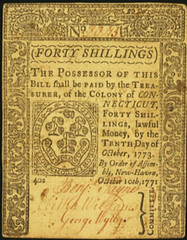

This uncancelled note is the highest denomination from a very scarce series. Very sharply printed, exemplifying the Timothy Green details in the border cuts and back cartouche. The signatures of Benj: Payne, Elisha Williams and George Wylly are sharply penned in red ink. This is the Newman plate note, illustrated on page 109 of the 5th edition of The Early Paper Money of America.
To read the complete lot description, see:
http://currency.ha.com/itm/colonial-notes/colony-of-connecticut-october-10-1771-40-shillings-fr-ct-168-pcgs-about-new-50-apparent/p/241618-12031.s?ic4=ListView-Thumbnail-071515
City of Burlington, NJ James Craft Private Scrip Note
Within the New Jersey Colonials is an exceedingly rare and possibly unique Burlington “U.S.A” private scrip note:
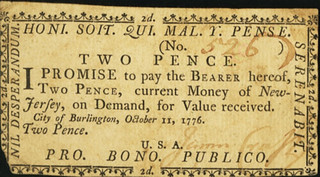
The private and municipal change notes comprise an interesting and less studied area of Colonial currency. They form a fascinating genre of "paper coins," and are eminently collectible with Colonial coins listed in the "Red Book." This is an exceedingly rare and possibly unique Revolutionary War period private scrip note. It is the Newman plate note, illustrated on page 262 of the 5th edition. The issuer was not in the James DuPont Collection; that definitive collection of Colonial era private issuer notes was auctioned by R.M. Smythe & Co. in two sales in 1993.
Printed on laid paper. Contained within a floral pattern border are: the typeset obligation across, TWO PENCE above and U.S.A. below. Four Latin mottoes are inside the border. From left clockwise: NIL DESPERANDUM. (Never lose hope), HONI. SOIT. QUI. MAL. Y. PENSE. (Evil to him who evil thinks), SERANABIT. (It will be calm), and along the bottom PRO. BONO. PUBLICO. (For the public good). The use of "U.S.A" is very interesting on a private scrip note.
To read the complete lot description, see:
http://currency.ha.com/itm/colonial-notes/city-of-burlington-new-jersey-usa-james-craft-i-promise-to-pay-the-bearer-2-pence-october-11-1776-newman-pag/p/241618-12160.s?ic4=ListView-ShortDescription-071515
Lansingburgh, NY Ananias Platt Scrip Note
The Lansingburgh, New York Ananias Platt 2 pence has been illustrated in all five editions of Newman:
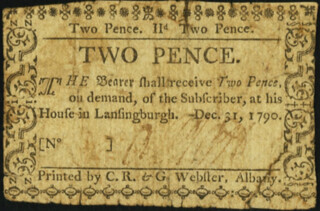
This is a very rare issuer, and the only two notes we have verified were in the DuPont Collection sale of March 1993 by R. M. Smythe & Co. The 2 pence in that sale was the Newman plate note, serial number 11, illustrated in the 5th and all prior editions. The note is uniface, printed on laid paper by C. R. & G. Webster, Albany, with imprint at the bottom. Fancy pattern bordering, wider at the ends, encloses the text and date. The denomination is at the top.
To read the complete lot description, see:
http://currency.ha.com/itm/colonial-notes/-lansingburgh-new-york-ananias-platt-at-his-house-in-lansingburgh-dec-31-1790-2-pence-newman-page-306-harris-h9-pcg/p/241618-12194.s?ic4=GalleryView-ShortDescription-071515
Linlithgow, NY Church Penny Scrip Note
The only reported Linlithgow church penny is both the Newman and Gordon Harris plate note:
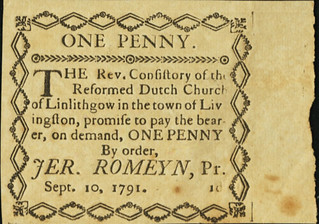
The sole reported note from this Columbia County church issuer. It is plated in two reference books: it is the Newman Plate Note illustrated on page 308 of the 5th edition and the Gordon Harris plate note, from a supplied photo, on page 84. This is a striking and very distinctive example. Nearly square, and in a larger format than most change bills from the period. Printed on laid paper, uniface, without an imprint. It shows diamond pattern bordering with corner floral stops. Engraved text is across with ONE PENNY at top end and engraved "JER. ROMEYN, Pr." at lower right; the date is underneath to the left. The right end has the full sheet edge, and the deeply embossed printing shows to the blank back. This is the only denomination and note known to us, though other denominations might exist according to the Newman text.
To read the complete lot description, see:
http://currency.ha.com/itm/colonial-notes/-linlithgow-new-york-rev-consistory-of-the-reformed-dutch-church-of-linlithgow-in-the-town-of-livingston-sept-10-1791/p/241618-12192.s?ic4=GalleryView-Thumbnail-071515
To view the complete preview of Selections from The Eric P. Newman Collection Internet Part 1, please click below:
http://currency.ha.com/c/search-results.zx?N=56+792+4294946527&ic=hero-Newman-Internet-Part1-PreviewLots-auction241618-031416

Archives International Auctions, Part XXXII
U.S., Chinese, Russian & Worldwide Banknotes,
Scripophily and Coins
April 11-13, 2016

Click the links! Highlights include:
Lot 62: French Guiana. 5 New Francs 1961 Provincial Issue
Lot 85: Guadeloupe, 1 Noveau Franc on 100 Francs
Lot 104: Reserve Bank of India "Persian Gulf Note"
Lot 111: Government of Iraq 10 Dinars of King Faisal II
Lot 201: Philippine Islands Silver Certificate Unique Presentation Proof
Lot 255: Francis Spinner Letter, 1871.
Lot 479: Copper Printing Plate Engraved By William Kneass, Chief Engraver
Lot 499: U.S. Legal Tender Treasury Note, Unique Presentation Proof, $10, Series of 1890
Lot 1056: Lao 1948 Unlisted Color Trial Specimen Essay Banknote
Lot 1351: Vladikavkaz Railroad Company 1919 Interest Bearing Loan Note Rarity
Lot 2053: Bank of China, 1918 "Tsining / Shangtung" Issue Rarity
Lot 2258: Deutsch-Asiatische Bank, 1907 "Peking" Branch Rarity
Lot 2319: Peiyang Tientsin Bank, ND (1910) Tael Issue
Lot 2263: Netherlands Trading Society, 1909 Issued Banknote
View the Virtual Catalog
Download the Catalog in PDF format
ARCHIVES INTERNATIONAL AUCTIONS, LLC
1580 Lemoine Avenue, Suite #7
Fort Lee, NJ 07024
Phone: 201-944-4800
Email: info@archivesinternational.com
WWW.ARCHIVESINTERNATIONAL.COM
BBC NEWS REPORTS ON VALUE OF 1794 DOLLAR
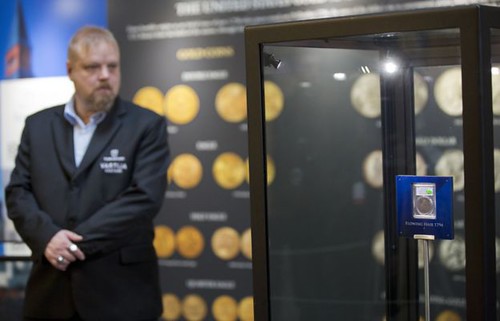
A US silver dollar worth more than $10m has gone on display in London. But what makes this coin the most valuable in the world?
It measures 4cm (1.6in) across and would make $12 if sold for scrap silver today, but the "Amon Carter" Flowing Hair Silver Dollar is a record-breaker. It was bought by a private collector in 2013 for $10m (about £7m).
The astonishing price-tag is thanks to it ticking three all-important boxes - rarity, condition and cultural value. But perhaps the greatest selling point is who handled it.
Many experts believe it could be the first dollar ever to be struck. This means President George Washington himself would have personally inspected it.
"To think that a coin from the late 18th Century has survived in this state of preservation is remarkable," says Steve Roach from Coin World.
"It's also beautiful, with pleasing toning, a bold strike and its surfaces show reflectivity that strongly suggests that it was given special care and attention when it was struck."
The whereabouts of the $10m coin between 1794 and 1920 are a mystery, although Deeny says the lack of wear and tear prove it was kept in private hands and was never in circulation.
It first appeared in records in 1920 when it was bought by a businessman known as Colonel Green. It has since had 11 owners and has increased in price from $1,250 in 1947 to $10m in 2013.
To read the complete article, see:
Why is this coin worth $10m? (www.bbc.com/news/magazine-35821154)
1850 DOUBLE EAGLE ILLUSTRATED
Carol Bastable writes:
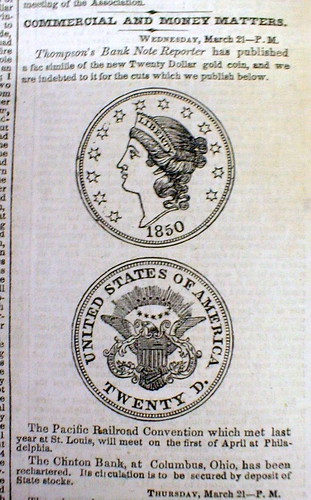 I found this while searching eBay and thought I would share it.
I found this while searching eBay and thought I would share it.
Back before television and mass media, sometimes news traveled slowly. That was the case with the famous 1883 no cent nickel that soon became used to defraud. In those days, news traveled from town to town through newspapers and it could be a great length of time for some to get news, especially for people living in the west. New issue coins and paper money could be troubling if merchants were not familiar with their release and design details. This 1850 newspaper, NEW-YORK WEEKLY TRIBUNE, published an illustration of the new twenty dollar Liberty gold coin. This was also at a time prior to photography in publishing, so having an image to publish required an artist's illustration.
This is a great item for competitive exhibitors as it can be challenging to find complimentary items to pair with U.S. coins. This is equally as interesting as it is important to collectors of these types of coins. Numismatic ephemera collectors will also find this item intriguing. The report is listed in a column under Commercial & Money Matters. On Wednesday March 21, 1850, Thompson's Bank Note Reporter published a facsimile image of the new coin and this New York paper picked up the story and image and passed it along to its readers.
To read the complete eBay lot description see:
1850 newspaper NUMISMATICS Image of LIBERTY Twenty Dollar Gold Coin DOUBLE EAGL
(www.ebay.com/itm/272105534438)

MARCH 2016 NUMMIS NOVA PHOTOS
Gene Brandenburg submitted these photos taken at the March 9, 2016 dinner meeting of Nummis Nova, my Northern Virginia numismatic social group. Thanks! For more information on the meeting, see last week's diary.
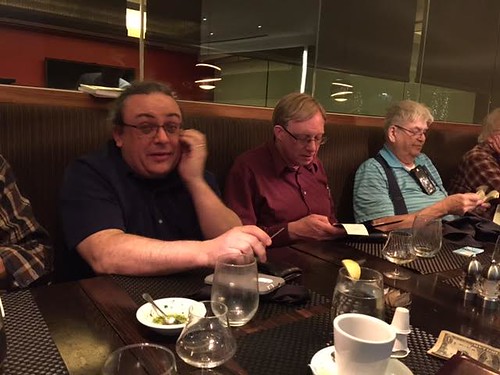
Eric Schena, Wayne Homren, Julian Leidman, Jon Radel
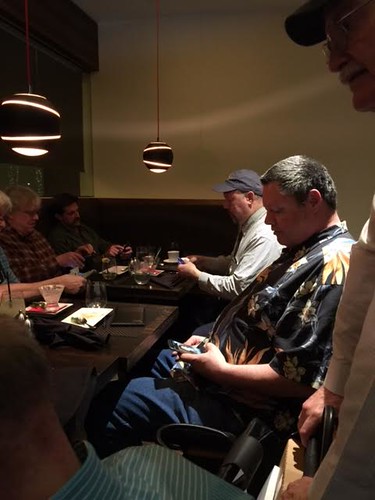
Left: Jon Radel, Wayne Herndon,
Right: Tom Kays, Robert Hoppensteadt, Howard Daniel (standing)
Gene also shared this photo of local coin dealer Joe Gallo in the shop he's had since 1964.
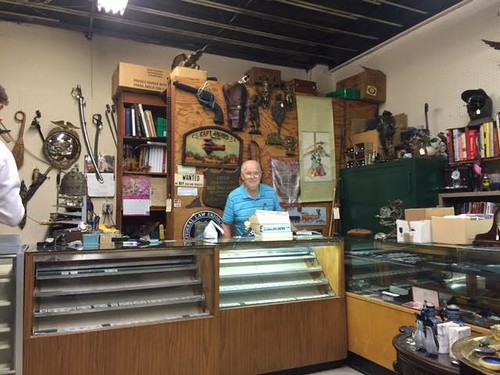
Joe Gallo
To read the earlier E-Sylum article, see:
WAYNE'S NUMISMATIC DIARY: MARCH 13, 2016
(www.coinbooks.org/esylum_v19n11a16.html)
THE BOOK BAZARRE
WAYNE'S NUMISMATIC DIARY: MARCH 20, 2016
An email last Sunday brought me a dinner invitation from Tom Uram of the Pennsylvania Association of Numismatists. Tom also wears the hat of a CCAC member, and the Citizens Coinage Advisory Committee was coming to town for a meeting Tuesday. Would I like to join them for dinner Monday? You bet!
I had the pleasure of joining a similar dinner last October (see my Diary, linked below). Just like last time I met everyone at the Embassy Row hotel off Dupont Circle. Tom met me and brought me over to a table in the lobby bar where everyone was gathering.
I gave Jeanne Stevens-Sollman a hug and congratulated Mike Moran on his new 1849 book, written with Jeff Garrett. Tom Uram was there with his brother Jim and this time their 95-year-old father Andy came along as well.
I immediately recognized longtime E-Sylum subscriber Donald Scarinci, who was signing a copy of his book on the Coin of the Year awards for another member. We had never met in person so I introduced myself when there was a break in the conversation. It's always great to convert an online friend to the in-person kind.
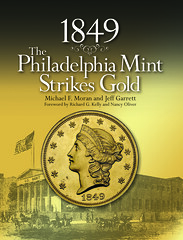
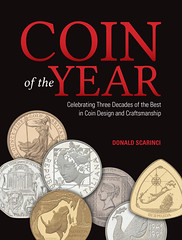
For more information on Mike and Don's books, see these earlier E-Sylum articles:
NEW BOOK: 1849: THE PHILADELPHIA MINT STRIKES GOLD
(www.coinbooks.org/esylum_v19n06a04.html)
NEW BOOK: COIN OF THE YEAR (www.coinbooks.org/esylum_v18n05a05.html)
BOOK REVIEW: COIN OF THE YEAR (www.coinbooks.org/esylum_v18n30a08.html)
While Donald had another dinner appointment in town, the rest of us stood up to head over to the Beacon Bar and Grill on Rhode Island Ave, when Mary Lannin had made a reservation. In the lobby we joined up with the rest of the group, including the newest CCAC members Steve Roach and Dennis Tucker. I hadn't seen either in person since the summer ANA convention, and I congratulated them both on their appointments.
Along the walk I got caught up with Robert Hoge, whom I didn't get a chance to speak with at the ANS Gala in January. He had just returned from Spain. I also got to meet Coin World columnist Lou Golino.
At dinner I sat next to Dennis Tucker and asked about the process of becoming a CCAC member. It's not a paid position, although travel expenses are reimbursed. There is an application process, and coincidentally the Mint just issued a call for applicants for the next two positions that will open up (however, current members can reapply). See the next article for more information. Dennis said he'd applied three times, and for him the third was a charm. So perseverance helps, and don't get discouraged if you don't make the cut - keep trying!
At my end of the table I could converse with the Urams, Dennis, Steve, Mary and Robert. Discussion topics included the Pacific Coast Numismatic Society, the Newman Numismatic Portal, the show tunes being sung at the piano bar across the restaurant, E-Sylum advertisers, and The Future (How do you pull over a self-driving car?). Here are some of my cellphone photos:
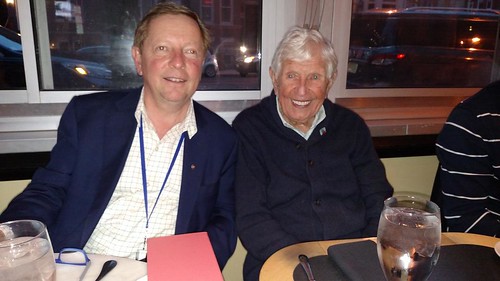
Tom Uram and his father Andy
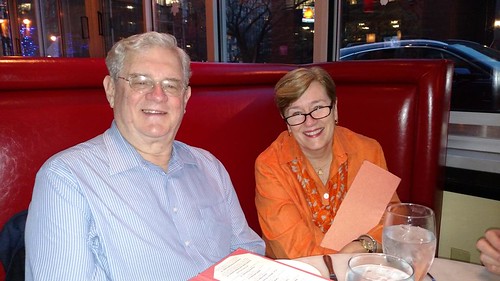
Robert Hoge and Mary Lannin

From left: Steve, Jeanne, Erik, Heidi, Mike Moran, Mike Olson
One thing we did NOT discuss were the decisions to be made at the next day's meeting. For a look at the considered designs (and there were a lot of them), see the Flickr collections at the links below:
Boys Town
https://www.flickr.com/gp/129211989@N07/fm1Mm1
2017 American Liberty High Relief Gold Coin
https://www.flickr.com/gp/129211989@N07/sWV36u
2017 American Eagle Platinum Proof
https://www.flickr.com/gp/129211989@N07/073MWj
Think this is a cushy job? Have a look at the design options and decide for yourself. Can you defend your decisions? Can you articulate why you prefer one design over another? There were 45 different Boy's Town design pairs and 78 individual obverse and reverse designs for the 2017 American Liberty High Relief Gold Coin.
I believe it was Mike Moran who told me this was the first time that obverse/reverse pairs by the same artist would be considered together for one of the coins. This ensures the artistic balance of obverse and reverse design style, which when considered separately can lead to what I would call "Frankenstein" coins, where the two sides are clearly from two different hands. It's not at all unusual of course, to have two different designers, but when their styles are very different the effect can be jarring.
The most controversial coin will likely be the 2017 high-relief gold coin which will feature an African-American figure as Liberty. I'm not sure if the directive came from Congress or the Mint, but why not? It's an allegorical figure, not an historical one. The image will seem out of place to many, but when Jackie Robinson first stepped on the field with his all-white teammates, that was an unusual sight, too. Not anymore.
But few members of the general public will end up seeing this coin, since it's not a general-circulation piece. That's a storm on the horizon. The movement for diversity on our paper money (see the Put a Woman on the $20 Bill movement) will come to circulating coinage at some point. CoinWeek Editor Charles Morgan discussed this at the end of his March 18, 2016 Weekly Coin Report.
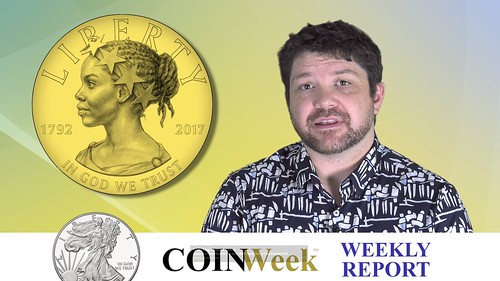
To watch Charles' Coin report video, see: CoinWeek Weekly Coin Report – March 18, 2016 – 4K Video (www.coinweek.com/recent-articles-video/weekly-coin-report-march-18-2016/)
After paying our checks Tom asked our waiter to take a group shot, so we all gathered 'round. Standing in the back from left to right are: Lou Golino, former CCAC member Mike Olson, Wayne Homren, CCAC members Robert Hoge, Erik Jansen, Steve Roach, Mary Lannin, and Mike Moran. Seated, from left to right are: CCAC members Tom Uram, Dennis Tucker, Heidi Wastweet, and Jeanne Stevens-Sollman.
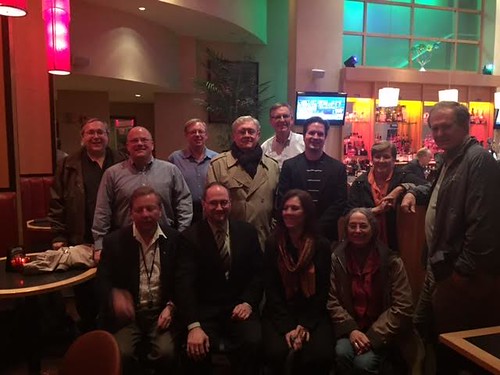
Image courtesy Tom Uram
Donald Scarinci shared some photos of the next day's meeting. Thanks! Here are a few.
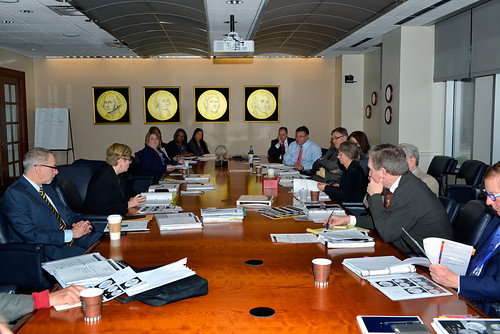
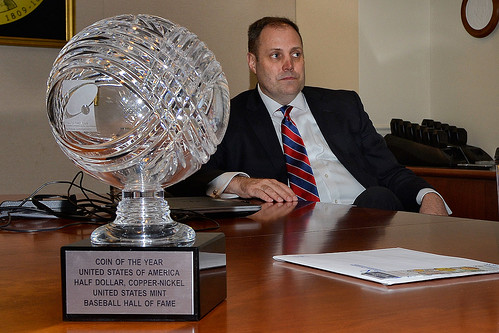
Rhett Jeppson a few hours before his confirmation hearing at the Senate Banking Committee.
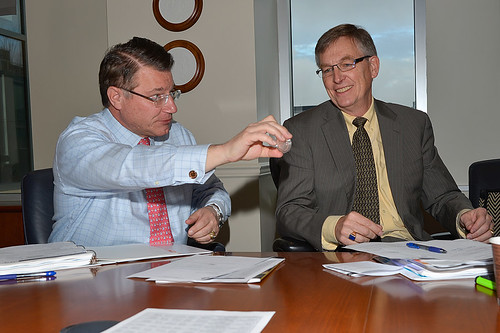
Former Acting Mint Director Richard Peterson holds a pattern for the 2017 Walking Liberty silver bullion coin with special edge lettering. Erik Jansen looks on
Donald Scarinci adds:
I don't know that there are many pictures of contemporary pattern coins being used for the purpose that they have been made--to show a sample of a design or strike characteristic of a production coin before it is made.
To view the entire photo album, see: Citizens Coinage Advisory Committee (www.flickr.com/photos/75739848@N03/sets/72157663662747714/with/25738377811/)
For more information on the CCAC members, see:
http://ccac.gov/aboutUs/members.cfm
To read the earlier E-Sylum article, see:
WAYNE'S NUMISMATIC DIARY: OCTOBER 11, 2015
(www.coinbooks.org/esylum_v18n41a18.html)
CITIZENS COINAGE ADVISORY COMMITTEE SEEKS TWO MEMBERS

The Citizens Coinage Advisory Committee has announced that it is seeking applications for two new members — one qualified to represent the “interests of the general public” and the other known for expertise in “numismatic curation.”
The positions entail making recommendations to the Secretary of the U.S. Treasury on topics such as coin and medal designs, commemorative themes, and mintage levels for commemorative coins. Each member serves a four-year term and is reimbursed for travel expenses related to the committee’s 6-8 yearly meetings. Aside from these expenses, the position is not salaried; officers or employees of the Federal Government are not eligible for the consideration.
Members of the 11-person committee are selected according to varying criteria. In addition to the above positions, one person is appointed for their knowledge of American history, one for knowledge in numismatics, one for experience with metallic arts or sculpture, two more (for a total of three) who represent the interest of the general public and four who have been recommended by U.S. House or Senate leadership.
According to a notice posted on the Federal Register, the committee is most interested in “candidates who have demonstrated leadership skills, have received recognition by their peers in their field of interest, have a record of participation in public service or activities, and are willing to commit the time and effort to participate in the CCAC meetings and related activities.”
Applications must be received or postmarked by April 1, 2016 and should include a resume and cover letter detailing a candidate’s reasons and qualifications for seeking membership. Submit materials via email to info@ccac.gov, by fax to 202-756-6525, or by mail to the United States Mint; 801 9th Street NW.; Washington, DC 20220, Attn: Greg Weinman.
CCAC members serve four-year terms; the two newest members of the committee, Dennis Tucker and Steve Roach, were officially appointed on February 3. For more information on the Citizens Coinage Advisory Committee, please visit its Web Site.
To read the complete article, see:
Citizens Coinage Advisory Committee Seeks
Two New Members (http://news.coinupdate.com/citizens-coinage-advisory-committee-seeks-two-new-members/)

ARCHIVES INTERNATIONAL SALE XXXII APRIL 11-13, 2016
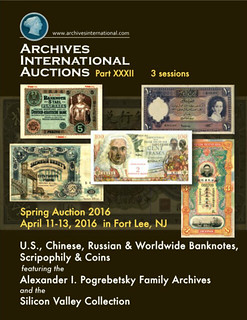 Over 1,700 lots of United States, Chinese, Russian and worldwide banknotes, coins, scripophily (stocks and bonds) and security printing
ephemera will be sold at a three-day auction, April 11-13, by Archives International Auctions, in the firm’s offices at 1580 Lemoine Avenue (Suite 7)
in Fort Lee. Start times all three days will be 10:30 a.m. Eastern time. The sale is available on their website at www.ArchivesInternational.com or
as a virtual catalog.
Over 1,700 lots of United States, Chinese, Russian and worldwide banknotes, coins, scripophily (stocks and bonds) and security printing
ephemera will be sold at a three-day auction, April 11-13, by Archives International Auctions, in the firm’s offices at 1580 Lemoine Avenue (Suite 7)
in Fort Lee. Start times all three days will be 10:30 a.m. Eastern time. The sale is available on their website at www.ArchivesInternational.com or
as a virtual catalog.
Monday, April 11th, will feature U.S. & worldwide banknotes and scripophily; Tuesday, April 12th, will contain Russian and worldwide banknotes and Chinese scripophily; and Wednesday, April 13th, will focus on Chinese banknotes. Nearly all the Chinese and Russian notes are from longstanding collections assembled over many decades and never previously offered at auction.
“We are privileged to offer additional rarities from the historic Alexander I. Pogrebetsky family archives of Chinese, Asian and Russian banknotes, plus early selections from the Silicon Valley collection of worldwide banknotes put together by an astute collector from 1960-1990 who had a keen eye for quality,” said Dr. Robert Schwartz, President of Archives International Auctions.
For those unable to attend in person, online bidding will be offered on the Archives International Auctions website: www.ArchivesInternational.com . Telephone and absentee (left) bids will also be accepted. The April 11th session (a live catalog sale) will be followed by a 300-lot, live and absentee, internet-only auction, with no printed catalog (though all items will be pictured online).
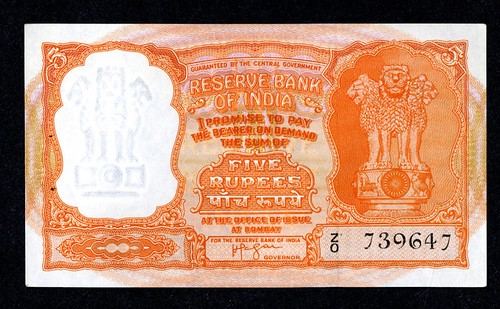
Session I, on Monday, April 11th, will begin with world banknotes, featuring the Silicon Valley collection of worldwide banknotes. French Colonial notes are highlighted in the collection and will include a French Guiana, 1961, 500 Francs graded Gem Unc. 65; two denominations of the Government of India, 1957 and 1959; and “Persian Gulf Note” issue notes boasting high grade.
Also sold will be an impressive group of 10 early Iraqi banknotes, to include the Government of Iraq, L.1931, 1 Dinar and 10 Dinars note rarities; an Italian Somaliland, 1951 Issue, 5 Somali, P- 16 in Choice Unc. 64; a Jordan Currency Board, 1952 Issue, 500 Fils with special serial # B/A 700007; and a group of 19 different early Mexico Banco era proof, specimen and issued notes.
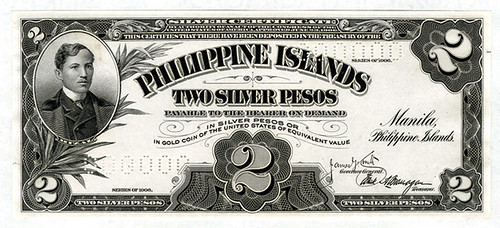
The April 11th session will continue with an extremely attractive and rare Oman Currency Board specimen set of eight denominations in Choice AU to Gem Uncirculated condition and rarely seen in this format; a unique Philippines Islands “Silver Certificate” presentation proof series of 1906, printed by the BEP; and numerous rare and desirable notes from nearly every continent.
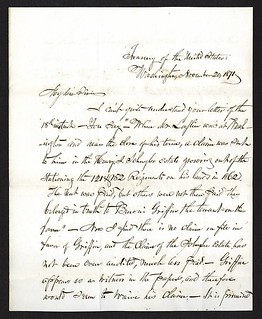 Further offerings will include a group of Francis Spinner letters, followed by a large scripophily section of issued and specimen stocks
and bonds including automobiles, railroads, foreign shares and bonds, mining, banking and finance, sugar companies and numerous additional topics.
Also included will be over 30 lots of security printing ephemera, with many rare and desirable items.
Further offerings will include a group of Francis Spinner letters, followed by a large scripophily section of issued and specimen stocks
and bonds including automobiles, railroads, foreign shares and bonds, mining, banking and finance, sugar companies and numerous additional topics.
Also included will be over 30 lots of security printing ephemera, with many rare and desirable items.
Obsolete United States banknotes promise to be a strong component of the April 11th session. Featured will be two different copper printing plates of early Tennessee and Georgia Scrip notes, circa 1820-1824, engraved by William Kneass, who was appointed Chief Engraver of the United States Mint in 1824. These historic printing plates are certain to attract considerable attention.
Also featured in the U.S. banknote section is a Serial #1, 1907 Panic Currency from the Seattle Clearing House Association; an amazing and unique BEP presentation proof of a Series 1890 Fr#366, U.S. Legal Tender U.S. Treasury note that was from the same presentation book as the Philippine proof offered earlier in the sale; and other desirable lots, thus concluding the session.
Session II, on Tuesday, April 12th, will consist of 534 lots, beginning with 93 lots of worldwide banknotes from Pacific Rim and Asian countries, including Sarawak, Strait Settlements, Japan, Thailand, South Vietnam, Philippines, Malaysia, Laos, Macau, Indonesia and other countries. They will be followed by 17 lots of attractive Japanese Yen coins in mostly AU to CU condition.
Also included will be over 100 lots of Chinese Imperial and Republic bonds, including Vickers Loans; 1913 Reorganisation Loans as well as numerous early railroad loans. The second day will ends with over 300 lots of Russian and related banknotes, with many rarities almost never seen at auction. The Alexander I. Pogrebetsky family archives are represented in this portion of the sale.
Highlights will include a Russian, 1923, 5 Rubles, P-178, Transport Certificate specimen; a Mineralnyie Vodyi District, 1919, 100 Rubles; two Vladikavkaz Railroad Co., 1918, 5,000 and 10,000 Rubles notes; examples from the Kazakhstan credits note issue, ND 1918 “Opium Note” series; and four denominations from the 1917 large format series of the Perm City Association.
Also sold will be hundreds of single and multiple banknote lots from the Pogrebetsky archives and the Silicon Valley collection, plus the Pogrebetsky collection of Russian coins, including early 1600s-1700’s wire money in silver and copper and early Russian silver and copper coins; and a large group of Russian private and local issues featuring rarely seen scrip and banknotes.
Additional Russian-related Harbin, China private and local notes will be offered in Session III of the Chinese banknote session on Wednesday, April 13th, which will feature 445 lots of Imperial Chinese, Republic, provincial, foreign, private and local banknotes and scrip notes, with many rarities including examples from the Pogrebetsky family archives and Silicon Valley collection.
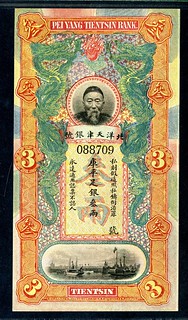 Highlights will include eight different Imperial Ch’ing Dynasty banknotes, including a 100,000 Cash, 1858 example, plus three different
Board of Revenue banknotes; an 1898 Imperial Bank of China, Shanghai Branch, ½ Tael banknote; and a very rare Chun Yih Sing Bank, ND (1875-1908)
“Peking” Branch, $1 issue rarity never before offered by Archives International Auctions.
Highlights will include eight different Imperial Ch’ing Dynasty banknotes, including a 100,000 Cash, 1858 example, plus three different
Board of Revenue banknotes; an 1898 Imperial Bank of China, Shanghai Branch, ½ Tael banknote; and a very rare Chun Yih Sing Bank, ND (1875-1908)
“Peking” Branch, $1 issue rarity never before offered by Archives International Auctions.
Also sold will be a Bank of China, 1912, $10 and a 1913, $1 “Canton” Branch issues; a Bank of China, 1914 “Yuan Ahih-Kai” issue proof banknote set, including five different notes ranging from 1 Yuan to 100 Yuan banknotes; a discovery Bank of China 1918 “Tsining / Shangtung” branch issue rarity that was previously unlisted; and other highly collectible notes and rarities.
Ten different pages of banknote photos from Pogrebetsky’s 1929 Chinese banknote reference book that he personally wrote, including some of the pages with the matching plate notes that were previously hinged to the pages from his personal reference book, will be sold, along with numerous group lots that will contain many hidden gems that should be examined carefully.
Additional highlights from Session III includes two different Bank of Territorial Development, 1915, Urga issue banknotes in high grade; 42 different Peoples Bank of China banknotes, with many high grade examples from the 1948 to 1956 issues; a 1907 Deutsch-Asiatsche “Peking” Branch 5 Tael high grade rarity; a Netherlands Trading Society, 1909, $10 issued banknote; and
These will include a $100, Russo-Asiatic Bank, 1917 “Harbin” Branch specimen graded highly, in Gem Uncirculated condition. Provincial banks will be highlighted by a Yokohama Specie Bank 1924 “Tsingtau” branch issue and a Peiyang Tientsin Bank, ND (1910) 3 Taels issue in Choice Uncirculated condition as well as many other desirable and highly collectible notes.
The third session will also include an assortment of private banks and local issues, highlighted by three different Shanghai issued military-related U.S. Marine Corp., 4th Regiment scrip notes, circa 1930-40. The 4th Regiment left Shanghai in 1941 after being based in China since 1927. They went to the Philippines, fought the Japanese, surrendered, and spent three years as POWs.
The catalog for the three-day, April 11th to 13th auction is now online at Archives International Auctions’ website and can be viewed via Archives International Auctions’ live bidding platform, as a virtual catalog, or downloadable as a .pdf. To pre-register for the live auction, or for more information on absentee internet bidding, you may log on to www.ArchivesInternational.com.
AMERICAN BANK NOTE BUILDING FOR SALE
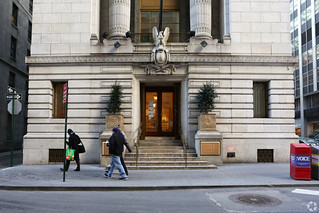 More than five years after picking up the American Bank Note Building in the Financial District for $18 million, a Chinese-based investment
and development firm is looking to sell the mixed-use asset for $88 million, Commercial Observer has learned.
More than five years after picking up the American Bank Note Building in the Financial District for $18 million, a Chinese-based investment
and development firm is looking to sell the mixed-use asset for $88 million, Commercial Observer has learned.
Douglas Elliman’s Neal Sroka, Anita Grossberg and Jennifer Hui Lo are listing the five-story, 19,000-square-foot granite landmark building (including a lower level) at 70 Broad Street between Beaver and Marketfield Streets that was built in 1908 by architecture firm Kirby, Petit & Green as the headquarters of the American Bank Note Company, an engraving company which produced bank notes, currency and stock certificates.
The seller, listed in CoStar Group as Gui Xin Hong, bought the 1908 building from Global Country of World Peace, a Transcendental Meditation nonprofit organization, on Dec. 20, 2010 for $18 million. The purpose was “to house their U.S. headquarters,” an Elliman spokesman said, noting that Mr. Sroka and Ms. Grossberg represented the buyer in that deal. The $18 million price tag was a serious reduction from the property’s final asking price of $25.5 million, according to The Wall Street Journal. The asking price started at $45 million in September 2009.
Dubbed the Peace Palace, 70 Broad Street received landmark designation in 1997. The building is comprised of commercial space, but for 4,260 square feet of residences on floors three to five, according to Douglas Elliman marketing materials. The building, which sits on a 3,060-square-foot lot, has a second-floor conference room.
To read the complete article, see:
Landmark American Bank Note
Building Hits Market for $88M (https://commercialobserver.com/2016/03/landmark-american-bank-note-building-hits-market-for-88m/)
To read the complete article, see:
American Bank Note Building in
FiDi back on market, asking $88M (http://therealdeal.com/2016/03/18/american-bank-note-building-in-fidi-back-on-market-asking-88m/)
THE BOOK BAZARRE
WILL ALEXANDER HAMILTON STAY ON THE $10 BILL AFTER ALL?
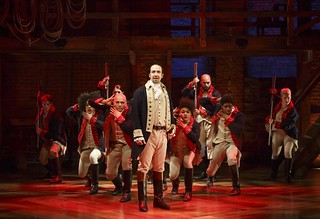 The $10 bill has been the subject of much discussion lately as the Treasury gets ready to re-design the note in order to better protect it
from counterfeiting. Of particular interest has been Treasury Secretary Jack Lew’s stated openness to adding a portrait of a woman to the
denomination.
The $10 bill has been the subject of much discussion lately as the Treasury gets ready to re-design the note in order to better protect it
from counterfeiting. Of particular interest has been Treasury Secretary Jack Lew’s stated openness to adding a portrait of a woman to the
denomination.
A spirited conversation followed the suggestion, with many commenters up in arms at the prospect of the $10 bill carrying an image of someone other than the co-author of The Federalist Papers. And when the Treasury implied that Hamilton would stay on the bill even as a woman was added, some advocates voiced their frustration that the woman selected for the honor would have to share the note.
Fast-forward a year and the legacy of Alexander Hamilton has found a surprising proponent on Broadway. Hamilton the musical was first performed in early 2015 and has since blown up into a cultural phenomenon. Using Alex Chernow’s biography of Hamilton as a guide, actor and composer Lin-Manuel Miranda re-imagined the founding father’s life story with a modern sensibility and a hip hop soundtrack, and has been rewarded with over-the-top ticket sales, rave reviews, and several awards.
This has led to a resurgence of interest in Hamilton the man, and Miranda spoke up for his subject in a recent meeting with none other than Secretary Lew himself.

The New York Times provided the following quote from a Treasury spokeswoman regarding the meeting:
“On Monday, Secretary Lew welcomed Lin-Manuel Miranda to the U.S. Department of the Treasury. The Secretary and Miranda talked about the enduring mark Alexander Hamilton left on our nation’s history and the Secretary provided a brief tour of Hamilton’s possessions and portraits on display at the Treasury Department. The Secretary thanked Miranda for the ingenious way in which he has been able to tell Hamilton’s story and ignite a renewed interest in one of our nation’s founding fathers. Sec. Lew also reiterated his commitment to continue to honor Alexander Hamilton on the 10 dollar bill.”
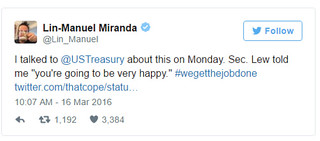
Secretary Lew also reiterated that Hamilton, the nation’s first Secretary of the Treasury, is one of his heroes. So whether or not Hamilton’s place on the 10 was ever in question, it’s now looking increasingly clear that he’s not going anywhere.
To read the complete article, see:
Alexander Hamilton’s Place on $10
Bill More Secure Thanks to Hamilton Musical
(http://news.coinupdate.com/alexander-hamilton-may-stay-on-10-bill-thanks-to-hamilton-musical/)
To read the complete article, see:
Hamilton May
Stay on the $10 Bill, Thanks to Help From Broadway
(www.nytimes.com/2016/03/17/theater/hamilton-may-stay-on-the-10-bill-thanks-to-help-from-broadway.html?ref=arts&_r=0)
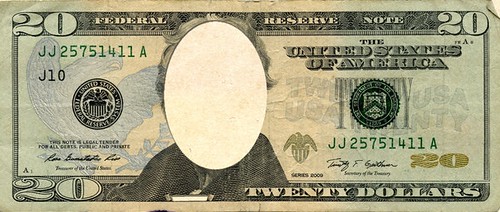
When we started “Women on 20s” a year ago to engage the nation in replacing Andrew Jackson with an iconic American woman on the $20 bill, we never imagined that Alexander Hamilton would be pleading for his life in a redesign of the $10 note. But now Lin-Manuel Miranda, the star who plays Hamilton in his own eponymous hit Broadway musical, is celebrating an assurance from Treasury Secretary Jacob Lew that Hamilton is safe. As Mr. Miranda tweeted to his followers, Lew told him, “You’re going to be very happy.” But will the redesign make women happy?
Anything short of a simultaneous redesign of the $20 bill giving women a place of their own in the all-male pantheon of our paper money is an affront. Sparked by our movement, hundreds of thousands of women and men have sent that message to the Treasury in the form of petitions, tweets and emails. Despite Secretary Lew’s hints in recent months that the back of the $10 bill offers ample real estate for honoring women, there is little evidence the public would support this compromise. We certainly don’t.
To read the complete article, see: A Woman’s Shot at the $20 (www.nytimes.com/2016/03/18/opinion/a-womans-shot-at-the-20.html?emc=edit_ty_20160318&nl=opinion&nlid=64598887&_r=0)
THE SMITHSONIAN'S WOMEN ON MONEY EXHIBIT
In June 2015 Secretary of the Treasury Jacob Lew announced that the 10 dollar note will be redesigned to feature a historic woman, marking the first major change in the appearance of U.S. paper money in nearly a century. This landmark announcement not only stimulated an unprecedented national discussion around the design of U.S. paper money, but it also provoked an extraordinary national conversation about the significant roles that women have played in the making of the nation.
To mark this historic moment, the museum will open a new display titled "Women on Money" on March 18, 2016, within the Stories on Money exhibition. This vibrant display will place the redesign of U.S. paper money into a global context and demonstrate that women have appeared on money from ancient times to the present day. These depictions commemorate women's contributions to national and world history and convey national ideals and ideas. Thus the display is organized around three themes: women on international money, women on American money, and female figures on money.
One of the first historic women to appear on money was Arsinoe II, a Ptolemaic queen of Egypt, in the 3rd century BCE. Since then, many national currencies have depicted women either during their lifetimes or posthumously. Female political leaders have appeared on money with the greatest frequency. Powerful women, like Pharaoh Cleopatra VII, Queen Elizabeth I, and Empress Maria Theresa, each issued coins with their portraits, helping them assert their influence over nations and empires. Modern female politicians, such as First Lady of Argentina Eva Perón and Prime Minister of India Indira Gandhi, have appeared on national currencies posthumously, commemorating their political leadership and helping to cement their places in their national histories.
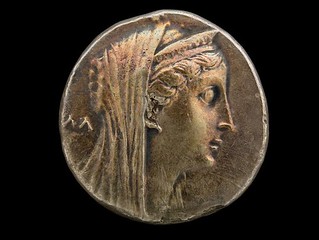
Arsinoe II, Decadrachm Coin, Egypt, 3rd Century BCE
In recent years, some governments have begun to reflect on the contributions women have made outside the political sphere and have chosen to honor women's achievements in the arts and sciences. For example, Poland has depicted the Nobel-prize winning chemist Marie Curie on the 20 zloty note; Italy has honored Maria Montessori, innovator in early childhood education, on the 1,000 lira note; and Fatma Aliye Topuz, a novelist and women's rights activist, has been honored on Turkey's 50 Lira note. Moreover, national communities are increasingly recognizing the role of female social activists as catalysts for change. Images of suffragettes, such as New Zealand's Kate Sheppard, have appeared on money as reminders of the importance of equality in a democratic society.
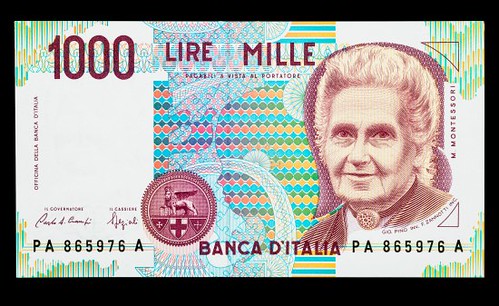
Maria Montessori, 1,000 Lira Note, Italy, 1990
To read the complete article, see:
Women on money (http://americanhistory.si.edu/blog/women-money/)

HOW THE WORLD'S CURRENCIES GOT THEIR NAMES
From country to country, monetary units vary nearly as much as the cultures and languages that use them. But have you ever wondered why a dollar is called a "dollar"? A recent post on the Oxford Dictionary's OxfordWords blog explained the origins of the names of the world's most common currencies. In the slides below, find out where these everyday words come from.
Dollar
The dollar is the world's most common currency, used in the US, Australia, Canada, Fiji, New Zealand, and Singapore and elsewhere.
According to OxfordWords, the Flemish or Low German word "joachimsthal" referred to Joachim's Valley, where silver was once mined. Coins minted from this mine became "joachimsthaler," which was later shortened to "thaler" and which eventually morphed into "dollar."
Peso
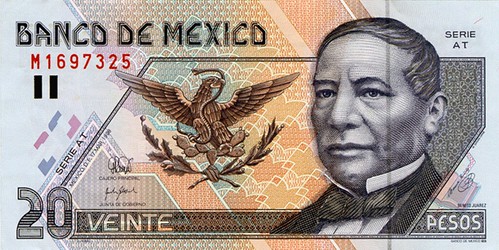
"Peso" literally means "weight" in Spanish.
Lira
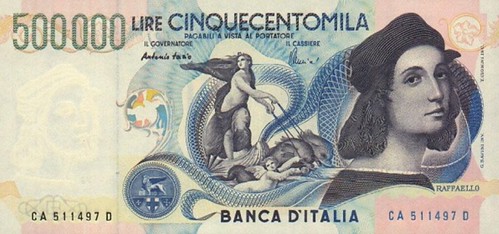
The Italian and Turkish "lira" come from the Latin word "libra," meaning "pound."
Rial
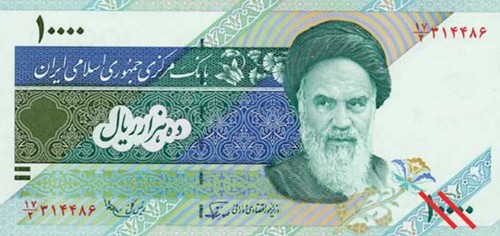
The Latin word "regalis," meaning "royal," is the origin for the Omani and Iranian "rial."
Similarly, Qatar, Saudi Arabia, and Yemen all use a currency called the "riyal." Before the euro, Spain used "reals" as well.
Chinese yuan, Japanese yen, and Korean won
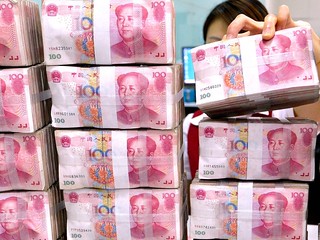
The Chinese character "圓," meaning "round" or "round coin," is responsible for the name of the Chinese yuan, Japanese yen, and Korean won.
Dinar
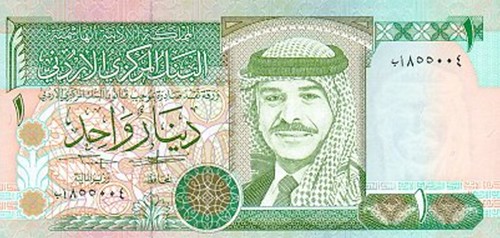
Jordan, Algeria, Serbia, and Kuwait all call their currency "dinar."
This is a pretty straightforward truncation of the Latin word "denarius," which was a silver coin used in ancient Rome.
Forint
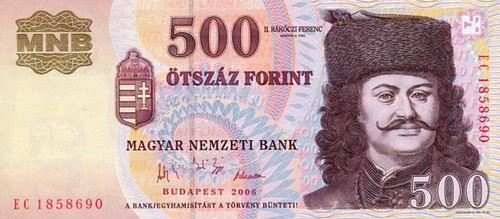
The Hungarian forint comes from the Italian word "fiorino," a gold coin from Florence.
The fiorino had a flower, or "fiore" in Italian, stamped on it.
To read the complete article, see:
How the world's currencies got their names
(www.businessinsider.com/how-currencies-got-their-names-2016-3)
OTTOMAN BANKNOTE EXHIBIT IN ISTANBUL
Mehmet S. Tezçakın, who owns the historic Sultanahmet Köftecisi restaurant, which is famous for its meatballs, has opened a money exhibition consisting of Ottoman banknotes at Moda Sea Club. Tezçakın's exhibition, "Banknotes in our History," is curated by researcher and numismatist Güçlü Kayral and is open until March 24 from 1:00 p.m. to 6:00 p.m.
Tezçakın has collected nearly 7,500 of the 12,000 Ottoman banknotes still in existence, making it the most comprehensive Ottoman banknote collection in the world and worth TL 6 million. He lifted a ban that had forbid visitors from touching the banknotes, enabling guests to get hands-on experience. "It is impossible to discover the details of the Ottoman banknotes, the important pieces of our history, by simply staring at them," Tezçakın said, explaining his surprising practice. "People should touch these paper bills and feel the hard work that was given to earning each banknote. One can only be a collector in this way. Since I consider each visitor a future collector, I decided to go through with this practice." At the inauguration of the exhibition, a panel session, "The History of Money and Our Banknotes," was held, and Tezçakın and Kayral were speakers.
Stamp banknotes
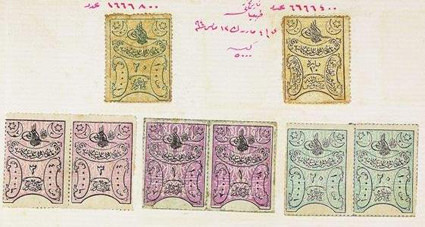
As banknotes were usually launched in high values during the Ottoman Empire, banknotes in small currencies - necessary for use in day-to-day trade -- were produced by people victimized by high value banknotes; thus, shopkeepers, bakers, stallholders and associations began circulating tickets as banknotes. The government placed cardboard on the back of stamps and turned them into money similar to coins. The Turkish phrase "Para pul oldu" (Money is turned into stamps) comes from this practice.
Torn 1-lira banknote
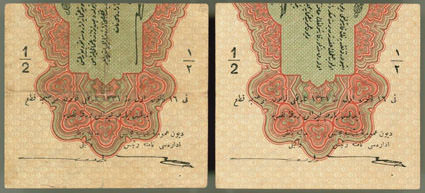
The most radical solution to the coin problem came into being in 1913. The 1-lira banknote was torn down the middle and circulated as a 50-kuruş banknote.
The 1 gold lira Ottoman Bank banknote

The multi-lingual structure of the Ottoman Empire that spread over a vast area was also reflected in everyday life, not just in banknotes. The 1-lira golden banknotes that were launched by the Ottoman Bank twice, in 1880 and 1890, were circulated in four different languages, including Ottoman, French, Armenian and Greek. It was the world's first and only banknote ever circulated in four different languages.
To read the complete article, see:
Ottoman banknotes with
striking stories on display (www.dailysabah.com/arts-culture/2016/03/17/ottoman-banknotes-with-striking-stories-on-display)

INDIAN OCEAN SHIPWRECK YIELDS RARE INDIO COIN
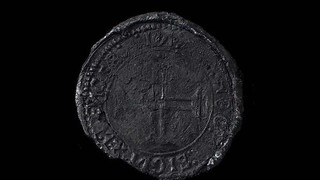 The 500-year-old wreckage of Portuguese ship piloted by an uncle of explorer Vasco da Gama has been found off the coast of Oman,
archaeologists said Tuesday, a discovery that included the recovery of an incredibly rare coin.
The 500-year-old wreckage of Portuguese ship piloted by an uncle of explorer Vasco da Gama has been found off the coast of Oman,
archaeologists said Tuesday, a discovery that included the recovery of an incredibly rare coin.
The Esmeralda sank during a violent storm near al-Hallaniyah Island in the Indian Ocean in May 1503, killing commander Vicente Sodre and all those aboard.
Among the stone shot, ceramics, a bell and other debris, divers discovered an incredibly rare silver coin called an Indio, of which only one other is known to exist today, said David L. Mearns, the director of Blue Water Recoveries. The coins were forged in 1499 after da Gama's first voyage to India, which helps date the wreckage, he said.
"That was an amazing discovery," Mearns said. "It was like a thing you read about in a Hollywood story."
The archaeologists announced their findings in an article published Tuesday by The International Journal of Nautical Archaeology.
David Sundman adds: It is amazing they were able to keep the find secret for 18 years.
To read the complete U.S. News article, see:
Remains of
1503 Shipwreck Found (www.usnews.com/news/science/articles/2016-03-15/site-of-1503-shipwreck-tied-to-vasco-da-gama-found-off-oman)
To read the CBS news article, see: Sunken treasure from a 500-year-old shipwreck (www.cbsnews.com/news/portuguese-ship-esmeralada-shipwreck-coin-artifacts-vasco-da-gama/)
To read the Times article, see: British team finds wreck and solves 500-year mystery (www.thetimes.co.uk/tto/news/uk/article4714981.ece?shareToken=542b481de04de004fe767208955e51a6)
ANCIENT EGYPT'S MOST LITERATE TRASH HEAP
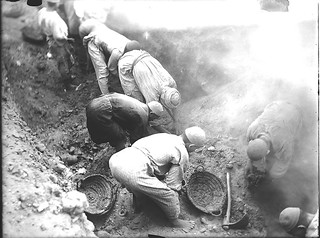 Although Pompeii and King Tut get the biggest headlines, the most informative archaeological site ever discovered isn't a town, temple,
or tomb: it's a massive garbage heap near (and partly underneath) El-Bahnasa, Egypt—a place called Oxyrhynchus.
Although Pompeii and King Tut get the biggest headlines, the most informative archaeological site ever discovered isn't a town, temple,
or tomb: it's a massive garbage heap near (and partly underneath) El-Bahnasa, Egypt—a place called Oxyrhynchus.
Oxyrhynchus is something special. It's in a desert where it never rains, and it's well outside any river's flood plain. It was a multi-cultural crossroads which was alternately part of the Nubian, Persian, Greek, Ptolemaic, Roman, Byzantine, and Fatimid empires. It held some of the earliest Christian monasteries and one of the oldest Egyptian mosques. Most importantly, it was a dumping ground for hundreds of thousands of pieces of papyrus—a wide-ranging library of classical texts, official records, personal correspondence, and grocery lists.
It's basically the closest thing we have to discovering the Library of Alexandria in a landfill. Academics familiar with it throw around terms like "unparalleled importance" and "holy grail" and aren't trying to be hyperbolic. It contained a lot of other ancient literature that would otherwise be totally lost–most famously a Sophocles comedy and the poetry of Sappho–not to mention extensive details about everyday life in Egypt, Greece, and Rome. It also held the biggest cache of early Christian manuscripts ever discovered.
Papyrus is much more durable than the wood-pulp paper we use today—durable enough to survive for 2,000 years. That alone wouldn't matter if it weren't for papyrus's other advantage: unlike vellum or parchment, it was cheap. As a result, although literacy in Ancient Egypt wasn't widespread by modern standards, the people who were able to write were able to write a lot, to such an extent that bureaucratic note-taking became its own cultural imperative—and that writing stuck around, at least partly because it wasn't expensive enough to be worth stealing or repurposing. (It did sometimes make good packing material, notably to wrap mummies.)
After more than a hundred years of steady effort by hundreds of scholars, we are still nowhere near transcribing everything that came out of the ground in that single decade. Nor the additional papyrus found by Italian digs in the 1920s and 1930s. Nor the further recovery by a Kuwaiti team in the 1980s.
The Oxford Archives have invited anyone with an internet connection to join the deciphering team. You don't even have to be able to read Greek (or Pahlavi, or Coptic, or Arabic, or Persian). All you have to do is visit the Ancient Lives site, look at scans, and press the letter buttons that resemble the shapes you see.
Or maybe you could take the trash out to the curb, and congratulate yourself on building one small piece of a future Oxyrhynchus
To read the complete article, see:
Oxyrhynchus, Ancient Egypt's Most
Literate Trash Heap (www.atlasobscura.com/articles/oxyrhynchus-ancient-egypts-most-literate-trash-heap)
COIN COLLECTING CONUNDRUMS
You are an experienced collector of modest means. You have far too many coins. You want to sell some and concentrate on your main interests. What would do in the following situations?
1. When you started out collecting your uncle gave you a George V crown he had when he was a boy. Before you got married, your future mother in law gave you a George III gold guinea and she said she wanted it to stay in the family. Neither fit in with your collection (the coins, not your mother in law).
2. One day you see some coins in a charity shop window. It is specimen set 1937, crown to Maundy penny for £18.00. You are later offered £200.00.
3. You go to your coin dealer and see a Charles I Crown. He says it is a fake but you think it is real. He wants £10.00 for it.
4. You look in his junk box and see a rare USA token from colonial times. The dealer says all are £1 each but when you show him this coin he wants to charge you £10.00.
Discuss
GARY BEALS: NUMISMATIC VOCABULARY RUN AMOK
I have been upset by that Dick Johnson!
He ran me through a device that caused me to thicken around the edges of my sides so now I can get next to others very easily. My face will
not wear as much because of that. He has raised the rim on both sides around my edge. Suddenly my burrs are gone, I am more perfectly
round, my edges are smooth and rounded and my edge is thickened. I am a Type II blank. I now have dreams of Matthew Boulton. Some guy
called me a wire edge but there’s no proof of that.
Welcome to numismatics where all the words you grew up with now have a different meaning.
Boulton's rimmer (the British word for upsetting) did five things: removed the burrs, smoothed the edge, rounded the edge, made the blanks perfectly round, and thicken the edge.
Dick Johnson also got me stoned — and then helped me get dressed
To get stoned numismatically you apply an abrasive to a metallic surface such as a die to remove raised metal, imperfections, or to smooth
the surface. Jewelry supply firms furnish abrasive stones – made of aluminum oxide or silicon carbide – in a dozen different forms and
grits for use by hand. It also supplies these abrasives mounted on shafts for power tools. For most diework stones of square shaped sticks
are used. These can be honed and sharpened to a point, useful for stoning a tiny area (they are even called pencil stones). These
are ideal for removal of small imperfections on a die. Stones can also be used for polishing.
After a die has been treated with such an abrasive stone it is said to be dressed.
Check back next week and learn how Dick causes hot shortness!
OK, I’ll tell you now: Hot shortness is cracks around edges of cast blanks (or cast objects) caused by different melting points of
impurities. Ancient coins often display evidence of such hot shortness – they were often made of impure metal and the blanks were heated
before striking. Low melting point metals, such as lead, were squeezed out during striking leaving the fissures around the edge.
Yours in shameless numismatic silliness, Gary Beals Segovia, Spain
FEATURED WEB PAGE: BRAZIL 960 REIS SILVER
This week's Featured Web Page is from the Coinshome.net site, featuring a collection of images of examples of the Brazillian 960 Reis silver coin.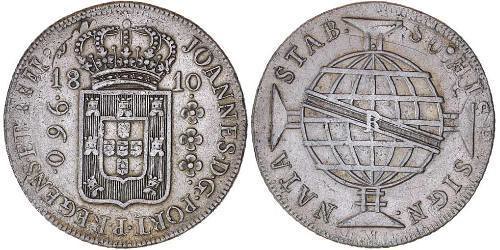
http://www.coinshome.net/en/coin_variations-960_Reis-Silver-Brazil-txfBwcI0AhIAAAEop9mPju1..htm


